Effects Of Safety Culture And Ethical Leadership Research Proposal 2022
VerifiedAdded on 2022/10/06
|22
|5672
|19
AI Summary
Contribute Materials
Your contribution can guide someone’s learning journey. Share your
documents today.
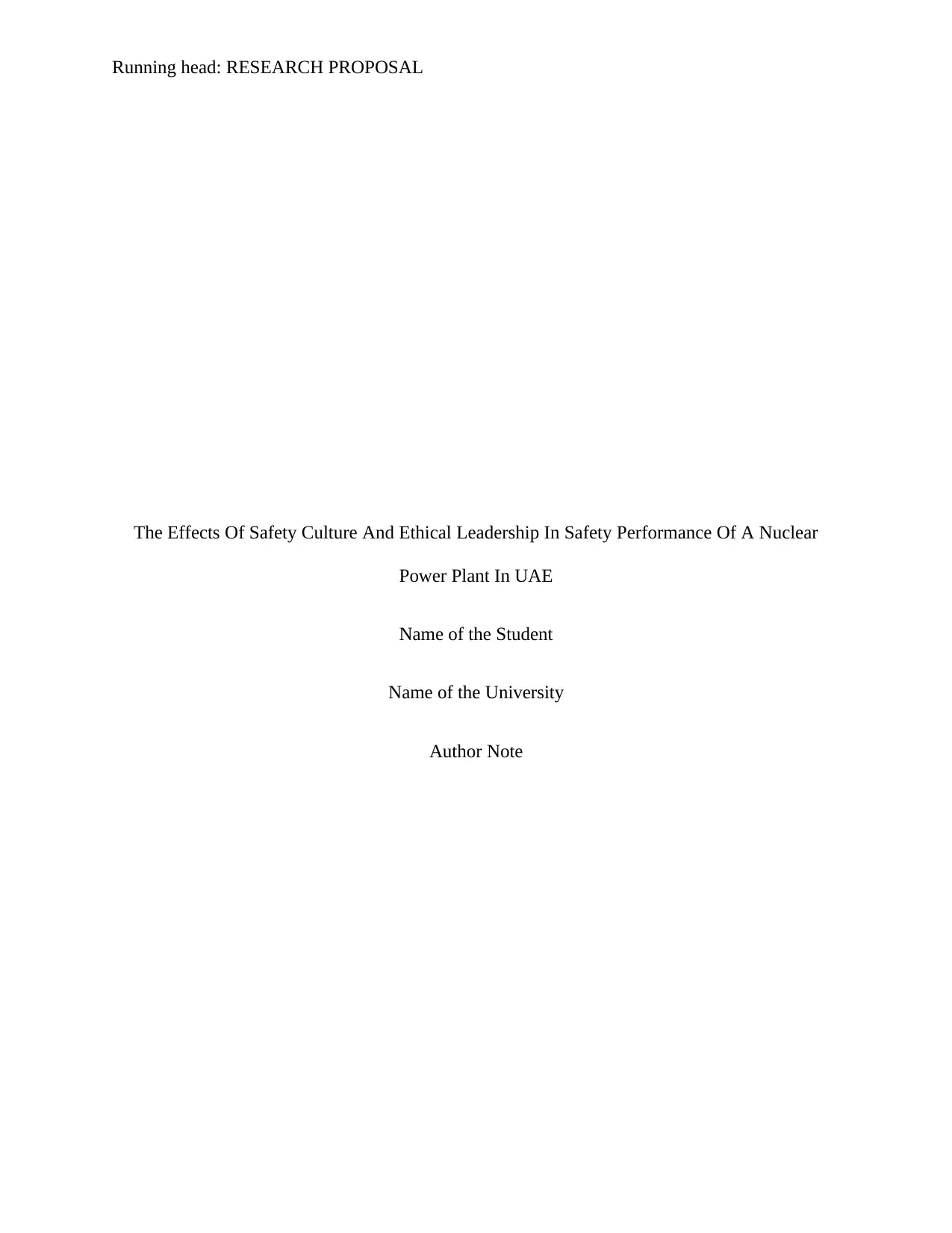
Running head: RESEARCH PROPOSAL
The Effects Of Safety Culture And Ethical Leadership In Safety Performance Of A Nuclear
Power Plant In UAE
Name of the Student
Name of the University
Author Note
The Effects Of Safety Culture And Ethical Leadership In Safety Performance Of A Nuclear
Power Plant In UAE
Name of the Student
Name of the University
Author Note
Secure Best Marks with AI Grader
Need help grading? Try our AI Grader for instant feedback on your assignments.
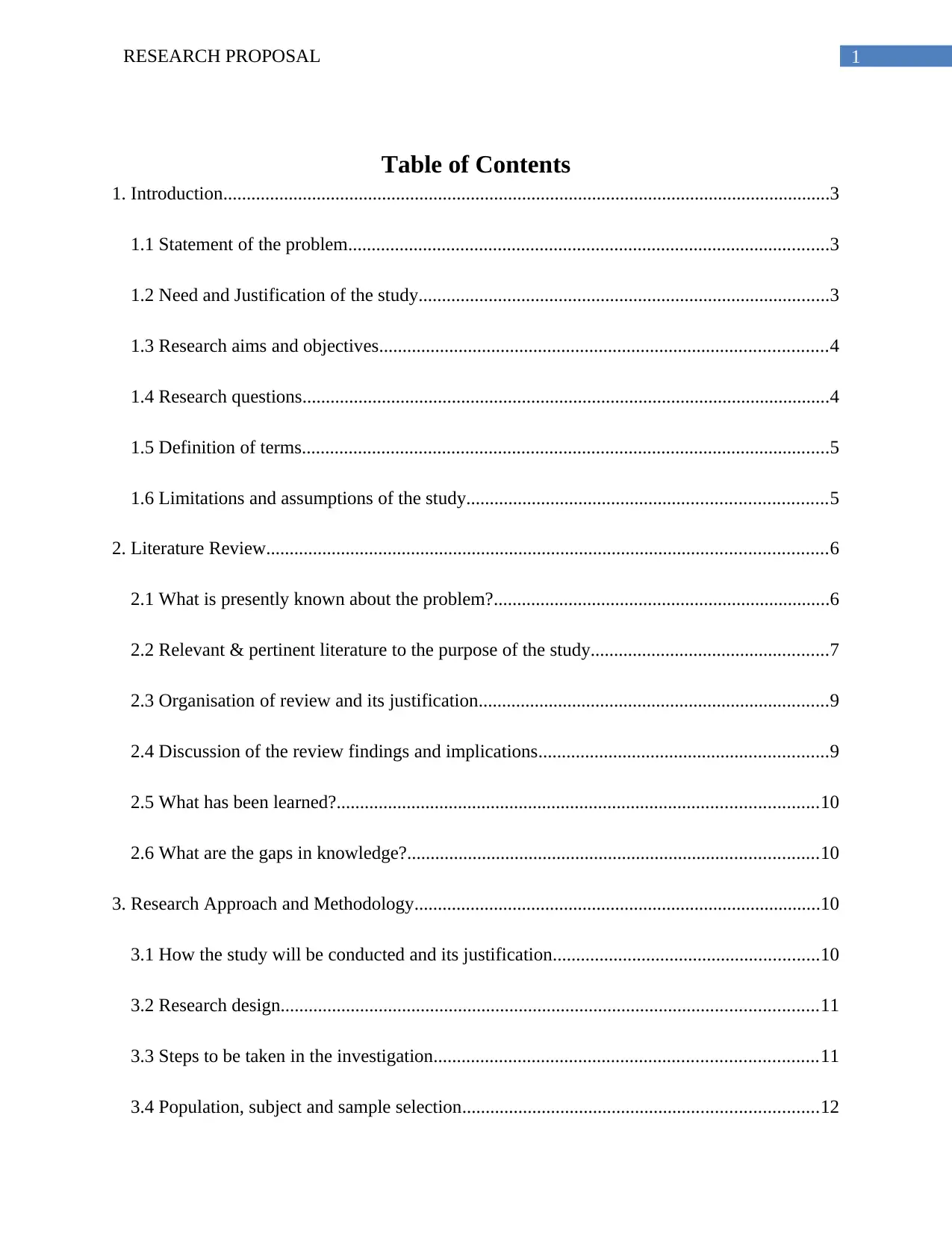
1RESEARCH PROPOSAL
Table of Contents
1. Introduction..................................................................................................................................3
1.1 Statement of the problem.......................................................................................................3
1.2 Need and Justification of the study........................................................................................3
1.3 Research aims and objectives................................................................................................4
1.4 Research questions.................................................................................................................4
1.5 Definition of terms.................................................................................................................5
1.6 Limitations and assumptions of the study.............................................................................5
2. Literature Review........................................................................................................................6
2.1 What is presently known about the problem?........................................................................6
2.2 Relevant & pertinent literature to the purpose of the study...................................................7
2.3 Organisation of review and its justification...........................................................................9
2.4 Discussion of the review findings and implications..............................................................9
2.5 What has been learned?.......................................................................................................10
2.6 What are the gaps in knowledge?........................................................................................10
3. Research Approach and Methodology.......................................................................................10
3.1 How the study will be conducted and its justification.........................................................10
3.2 Research design...................................................................................................................11
3.3 Steps to be taken in the investigation..................................................................................11
3.4 Population, subject and sample selection............................................................................12
Table of Contents
1. Introduction..................................................................................................................................3
1.1 Statement of the problem.......................................................................................................3
1.2 Need and Justification of the study........................................................................................3
1.3 Research aims and objectives................................................................................................4
1.4 Research questions.................................................................................................................4
1.5 Definition of terms.................................................................................................................5
1.6 Limitations and assumptions of the study.............................................................................5
2. Literature Review........................................................................................................................6
2.1 What is presently known about the problem?........................................................................6
2.2 Relevant & pertinent literature to the purpose of the study...................................................7
2.3 Organisation of review and its justification...........................................................................9
2.4 Discussion of the review findings and implications..............................................................9
2.5 What has been learned?.......................................................................................................10
2.6 What are the gaps in knowledge?........................................................................................10
3. Research Approach and Methodology.......................................................................................10
3.1 How the study will be conducted and its justification.........................................................10
3.2 Research design...................................................................................................................11
3.3 Steps to be taken in the investigation..................................................................................11
3.4 Population, subject and sample selection............................................................................12
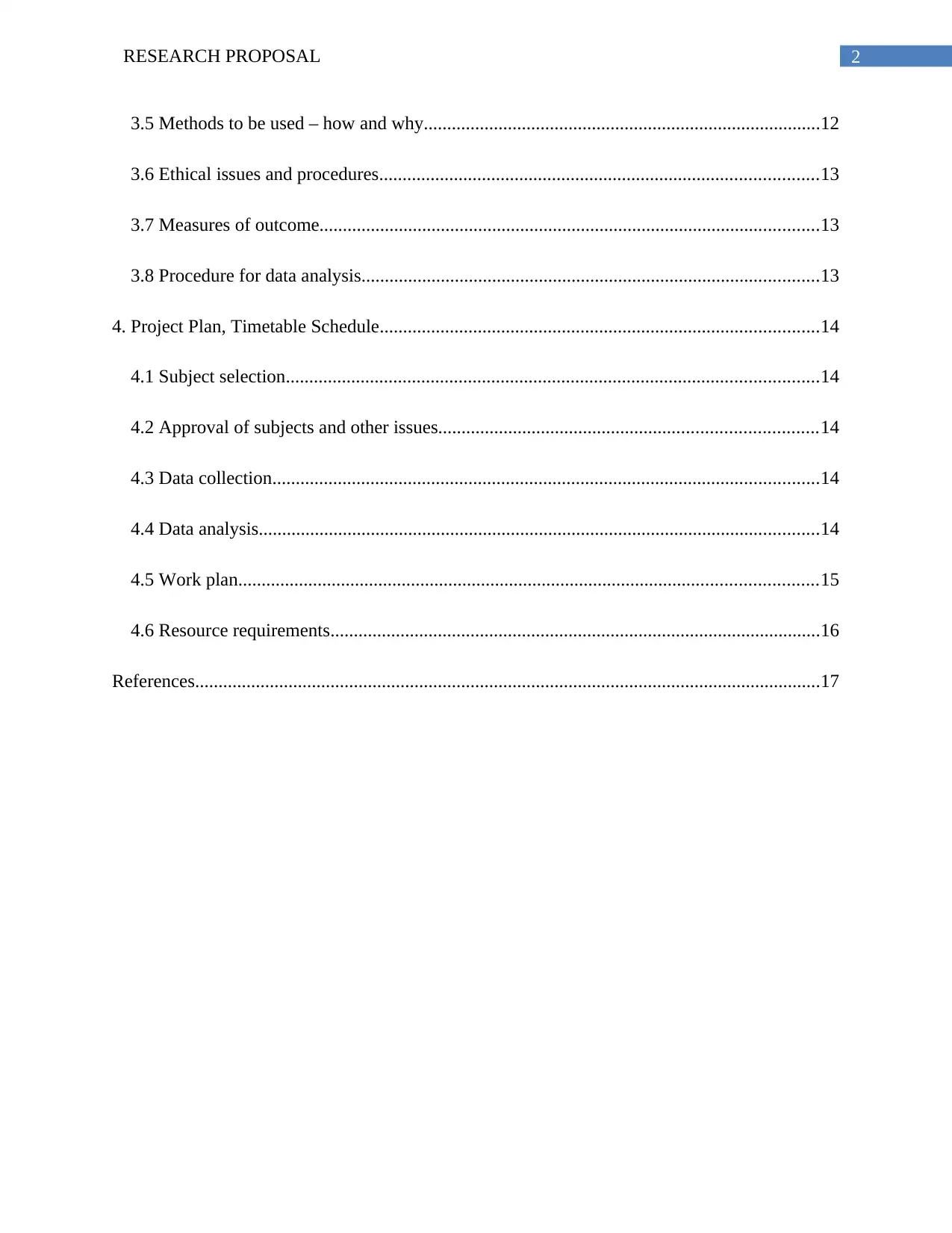
2RESEARCH PROPOSAL
3.5 Methods to be used – how and why.....................................................................................12
3.6 Ethical issues and procedures..............................................................................................13
3.7 Measures of outcome...........................................................................................................13
3.8 Procedure for data analysis..................................................................................................13
4. Project Plan, Timetable Schedule..............................................................................................14
4.1 Subject selection..................................................................................................................14
4.2 Approval of subjects and other issues.................................................................................14
4.3 Data collection.....................................................................................................................14
4.4 Data analysis........................................................................................................................14
4.5 Work plan............................................................................................................................15
4.6 Resource requirements.........................................................................................................16
References......................................................................................................................................17
3.5 Methods to be used – how and why.....................................................................................12
3.6 Ethical issues and procedures..............................................................................................13
3.7 Measures of outcome...........................................................................................................13
3.8 Procedure for data analysis..................................................................................................13
4. Project Plan, Timetable Schedule..............................................................................................14
4.1 Subject selection..................................................................................................................14
4.2 Approval of subjects and other issues.................................................................................14
4.3 Data collection.....................................................................................................................14
4.4 Data analysis........................................................................................................................14
4.5 Work plan............................................................................................................................15
4.6 Resource requirements.........................................................................................................16
References......................................................................................................................................17
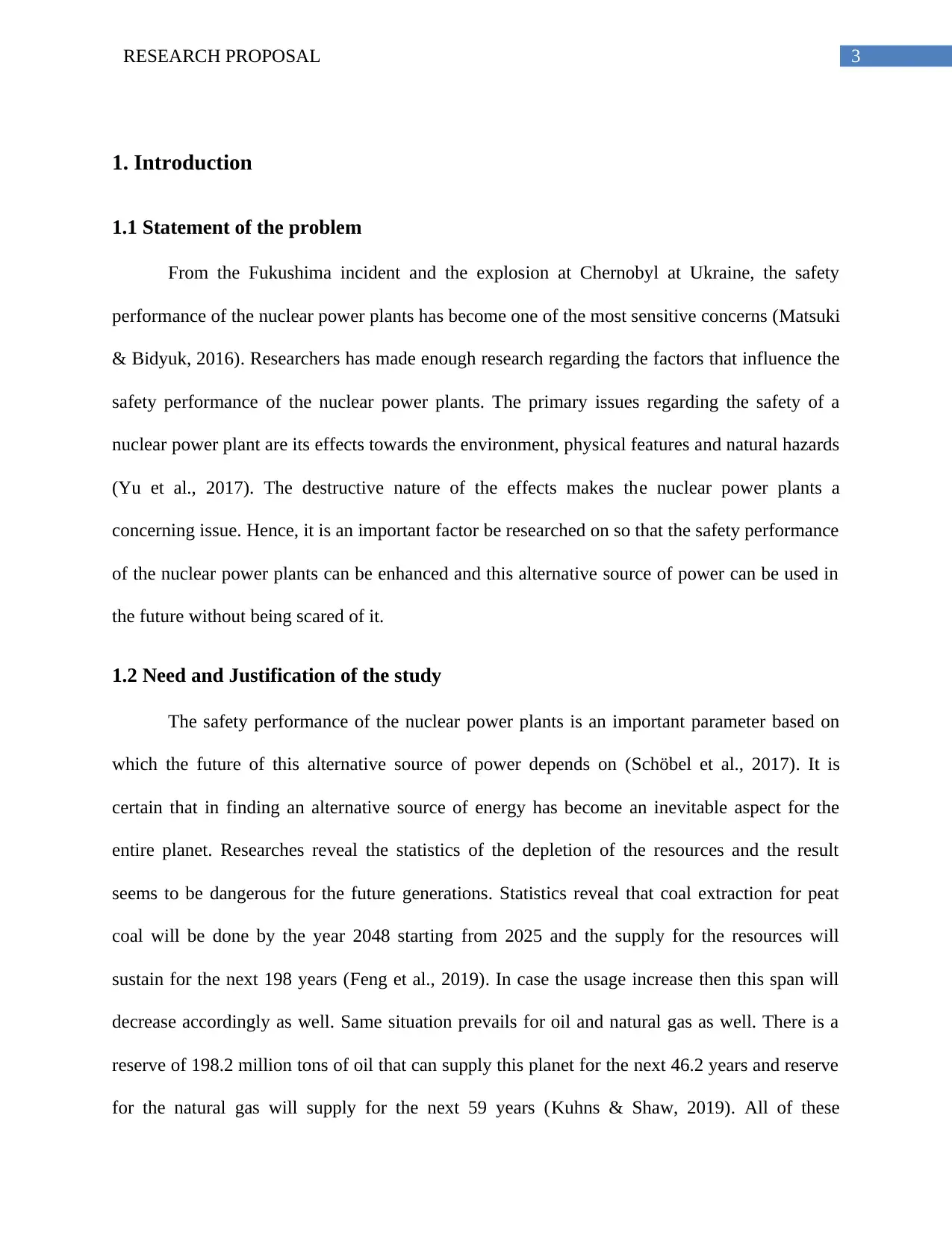
3RESEARCH PROPOSAL
1. Introduction
1.1 Statement of the problem
From the Fukushima incident and the explosion at Chernobyl at Ukraine, the safety
performance of the nuclear power plants has become one of the most sensitive concerns (Matsuki
& Bidyuk, 2016). Researchers has made enough research regarding the factors that influence the
safety performance of the nuclear power plants. The primary issues regarding the safety of a
nuclear power plant are its effects towards the environment, physical features and natural hazards
(Yu et al., 2017). The destructive nature of the effects makes the nuclear power plants a
concerning issue. Hence, it is an important factor be researched on so that the safety performance
of the nuclear power plants can be enhanced and this alternative source of power can be used in
the future without being scared of it.
1.2 Need and Justification of the study
The safety performance of the nuclear power plants is an important parameter based on
which the future of this alternative source of power depends on (Schöbel et al., 2017). It is
certain that in finding an alternative source of energy has become an inevitable aspect for the
entire planet. Researches reveal the statistics of the depletion of the resources and the result
seems to be dangerous for the future generations. Statistics reveal that coal extraction for peat
coal will be done by the year 2048 starting from 2025 and the supply for the resources will
sustain for the next 198 years (Feng et al., 2019). In case the usage increase then this span will
decrease accordingly as well. Same situation prevails for oil and natural gas as well. There is a
reserve of 198.2 million tons of oil that can supply this planet for the next 46.2 years and reserve
for the natural gas will supply for the next 59 years (Kuhns & Shaw, 2019). All of these
1. Introduction
1.1 Statement of the problem
From the Fukushima incident and the explosion at Chernobyl at Ukraine, the safety
performance of the nuclear power plants has become one of the most sensitive concerns (Matsuki
& Bidyuk, 2016). Researchers has made enough research regarding the factors that influence the
safety performance of the nuclear power plants. The primary issues regarding the safety of a
nuclear power plant are its effects towards the environment, physical features and natural hazards
(Yu et al., 2017). The destructive nature of the effects makes the nuclear power plants a
concerning issue. Hence, it is an important factor be researched on so that the safety performance
of the nuclear power plants can be enhanced and this alternative source of power can be used in
the future without being scared of it.
1.2 Need and Justification of the study
The safety performance of the nuclear power plants is an important parameter based on
which the future of this alternative source of power depends on (Schöbel et al., 2017). It is
certain that in finding an alternative source of energy has become an inevitable aspect for the
entire planet. Researches reveal the statistics of the depletion of the resources and the result
seems to be dangerous for the future generations. Statistics reveal that coal extraction for peat
coal will be done by the year 2048 starting from 2025 and the supply for the resources will
sustain for the next 198 years (Feng et al., 2019). In case the usage increase then this span will
decrease accordingly as well. Same situation prevails for oil and natural gas as well. There is a
reserve of 198.2 million tons of oil that can supply this planet for the next 46.2 years and reserve
for the natural gas will supply for the next 59 years (Kuhns & Shaw, 2019). All of these
Secure Best Marks with AI Grader
Need help grading? Try our AI Grader for instant feedback on your assignments.
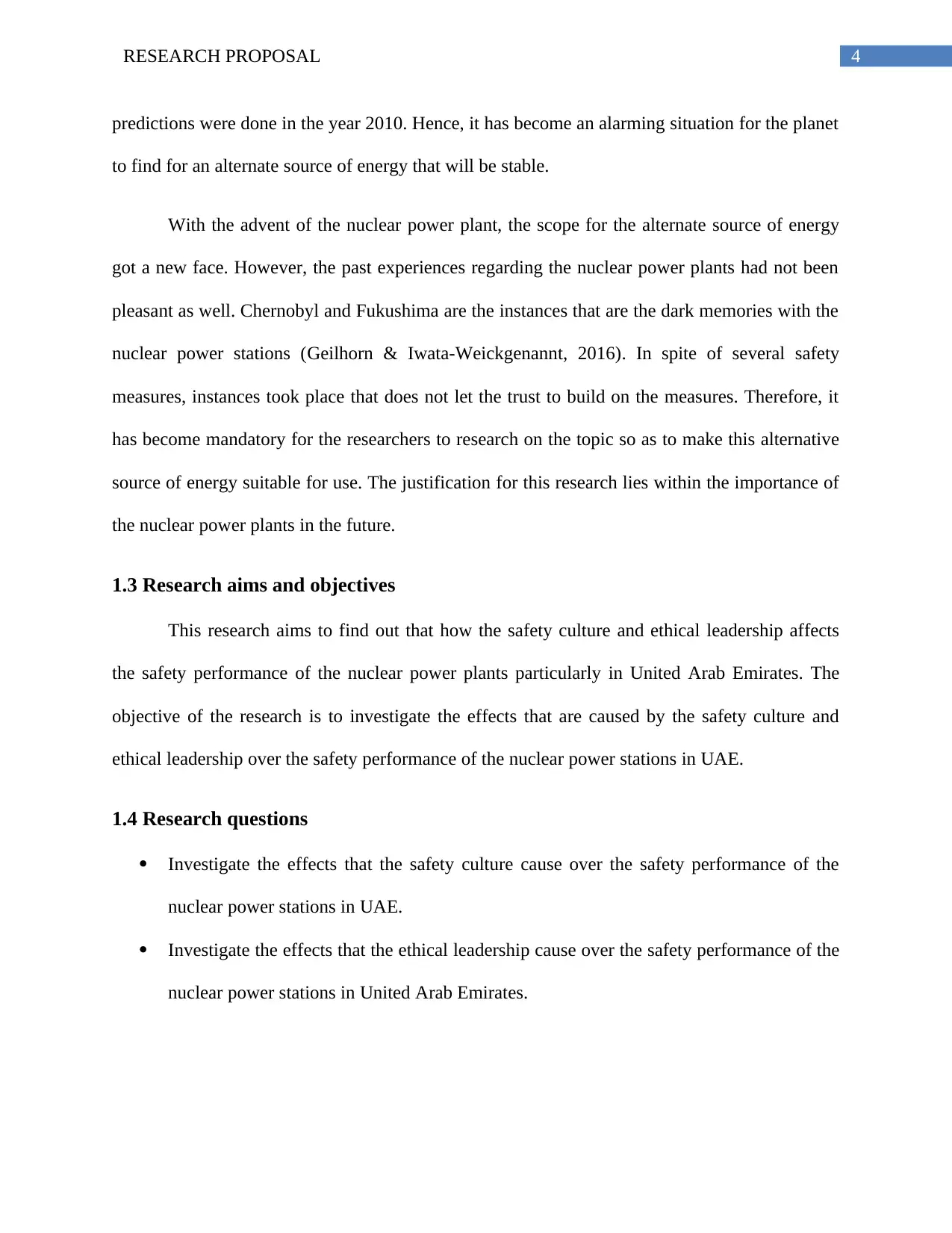
4RESEARCH PROPOSAL
predictions were done in the year 2010. Hence, it has become an alarming situation for the planet
to find for an alternate source of energy that will be stable.
With the advent of the nuclear power plant, the scope for the alternate source of energy
got a new face. However, the past experiences regarding the nuclear power plants had not been
pleasant as well. Chernobyl and Fukushima are the instances that are the dark memories with the
nuclear power stations (Geilhorn & Iwata-Weickgenannt, 2016). In spite of several safety
measures, instances took place that does not let the trust to build on the measures. Therefore, it
has become mandatory for the researchers to research on the topic so as to make this alternative
source of energy suitable for use. The justification for this research lies within the importance of
the nuclear power plants in the future.
1.3 Research aims and objectives
This research aims to find out that how the safety culture and ethical leadership affects
the safety performance of the nuclear power plants particularly in United Arab Emirates. The
objective of the research is to investigate the effects that are caused by the safety culture and
ethical leadership over the safety performance of the nuclear power stations in UAE.
1.4 Research questions
Investigate the effects that the safety culture cause over the safety performance of the
nuclear power stations in UAE.
Investigate the effects that the ethical leadership cause over the safety performance of the
nuclear power stations in United Arab Emirates.
predictions were done in the year 2010. Hence, it has become an alarming situation for the planet
to find for an alternate source of energy that will be stable.
With the advent of the nuclear power plant, the scope for the alternate source of energy
got a new face. However, the past experiences regarding the nuclear power plants had not been
pleasant as well. Chernobyl and Fukushima are the instances that are the dark memories with the
nuclear power stations (Geilhorn & Iwata-Weickgenannt, 2016). In spite of several safety
measures, instances took place that does not let the trust to build on the measures. Therefore, it
has become mandatory for the researchers to research on the topic so as to make this alternative
source of energy suitable for use. The justification for this research lies within the importance of
the nuclear power plants in the future.
1.3 Research aims and objectives
This research aims to find out that how the safety culture and ethical leadership affects
the safety performance of the nuclear power plants particularly in United Arab Emirates. The
objective of the research is to investigate the effects that are caused by the safety culture and
ethical leadership over the safety performance of the nuclear power stations in UAE.
1.4 Research questions
Investigate the effects that the safety culture cause over the safety performance of the
nuclear power stations in UAE.
Investigate the effects that the ethical leadership cause over the safety performance of the
nuclear power stations in United Arab Emirates.
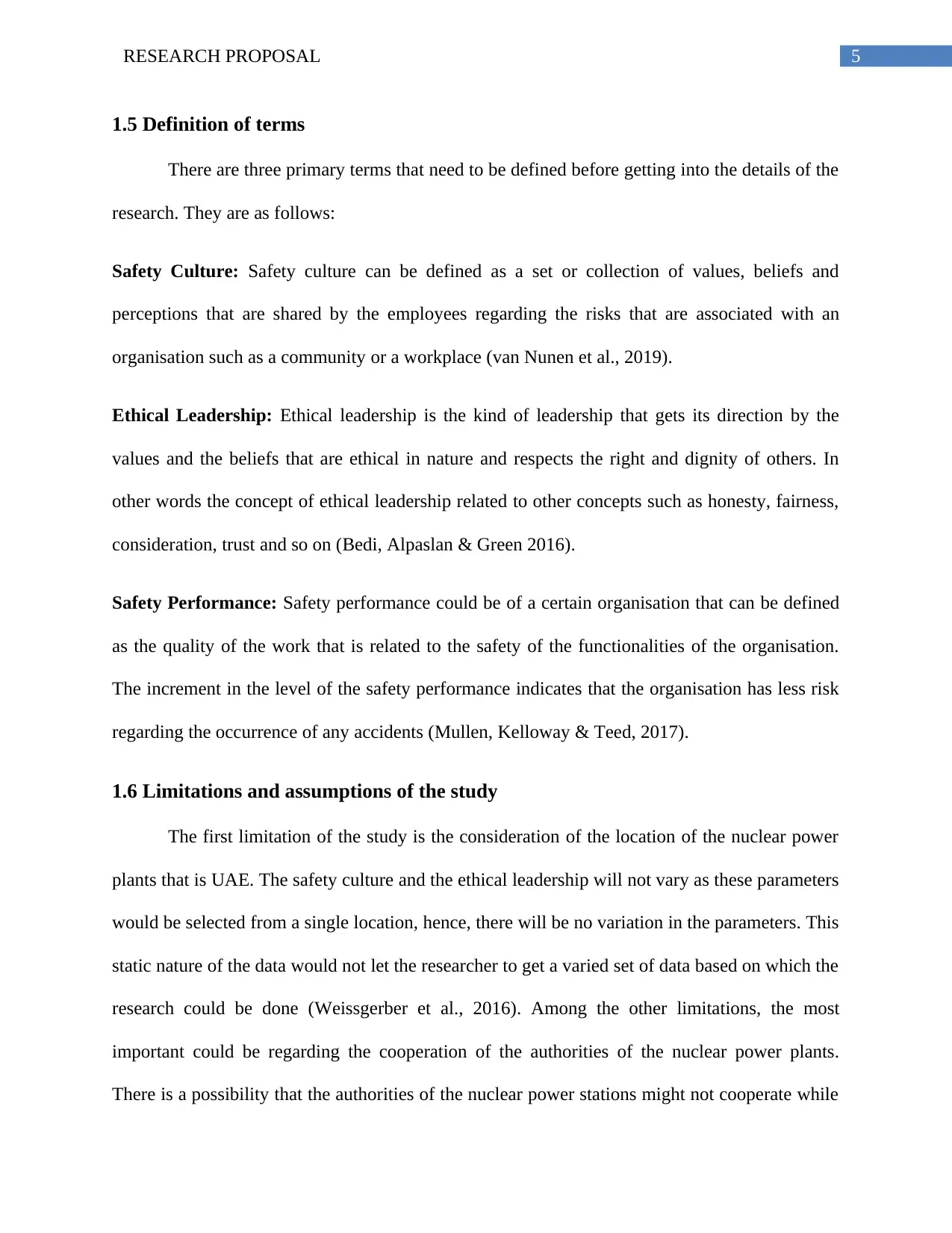
5RESEARCH PROPOSAL
1.5 Definition of terms
There are three primary terms that need to be defined before getting into the details of the
research. They are as follows:
Safety Culture: Safety culture can be defined as a set or collection of values, beliefs and
perceptions that are shared by the employees regarding the risks that are associated with an
organisation such as a community or a workplace (van Nunen et al., 2019).
Ethical Leadership: Ethical leadership is the kind of leadership that gets its direction by the
values and the beliefs that are ethical in nature and respects the right and dignity of others. In
other words the concept of ethical leadership related to other concepts such as honesty, fairness,
consideration, trust and so on (Bedi, Alpaslan & Green 2016).
Safety Performance: Safety performance could be of a certain organisation that can be defined
as the quality of the work that is related to the safety of the functionalities of the organisation.
The increment in the level of the safety performance indicates that the organisation has less risk
regarding the occurrence of any accidents (Mullen, Kelloway & Teed, 2017).
1.6 Limitations and assumptions of the study
The first limitation of the study is the consideration of the location of the nuclear power
plants that is UAE. The safety culture and the ethical leadership will not vary as these parameters
would be selected from a single location, hence, there will be no variation in the parameters. This
static nature of the data would not let the researcher to get a varied set of data based on which the
research could be done (Weissgerber et al., 2016). Among the other limitations, the most
important could be regarding the cooperation of the authorities of the nuclear power plants.
There is a possibility that the authorities of the nuclear power stations might not cooperate while
1.5 Definition of terms
There are three primary terms that need to be defined before getting into the details of the
research. They are as follows:
Safety Culture: Safety culture can be defined as a set or collection of values, beliefs and
perceptions that are shared by the employees regarding the risks that are associated with an
organisation such as a community or a workplace (van Nunen et al., 2019).
Ethical Leadership: Ethical leadership is the kind of leadership that gets its direction by the
values and the beliefs that are ethical in nature and respects the right and dignity of others. In
other words the concept of ethical leadership related to other concepts such as honesty, fairness,
consideration, trust and so on (Bedi, Alpaslan & Green 2016).
Safety Performance: Safety performance could be of a certain organisation that can be defined
as the quality of the work that is related to the safety of the functionalities of the organisation.
The increment in the level of the safety performance indicates that the organisation has less risk
regarding the occurrence of any accidents (Mullen, Kelloway & Teed, 2017).
1.6 Limitations and assumptions of the study
The first limitation of the study is the consideration of the location of the nuclear power
plants that is UAE. The safety culture and the ethical leadership will not vary as these parameters
would be selected from a single location, hence, there will be no variation in the parameters. This
static nature of the data would not let the researcher to get a varied set of data based on which the
research could be done (Weissgerber et al., 2016). Among the other limitations, the most
important could be regarding the cooperation of the authorities of the nuclear power plants.
There is a possibility that the authorities of the nuclear power stations might not cooperate while
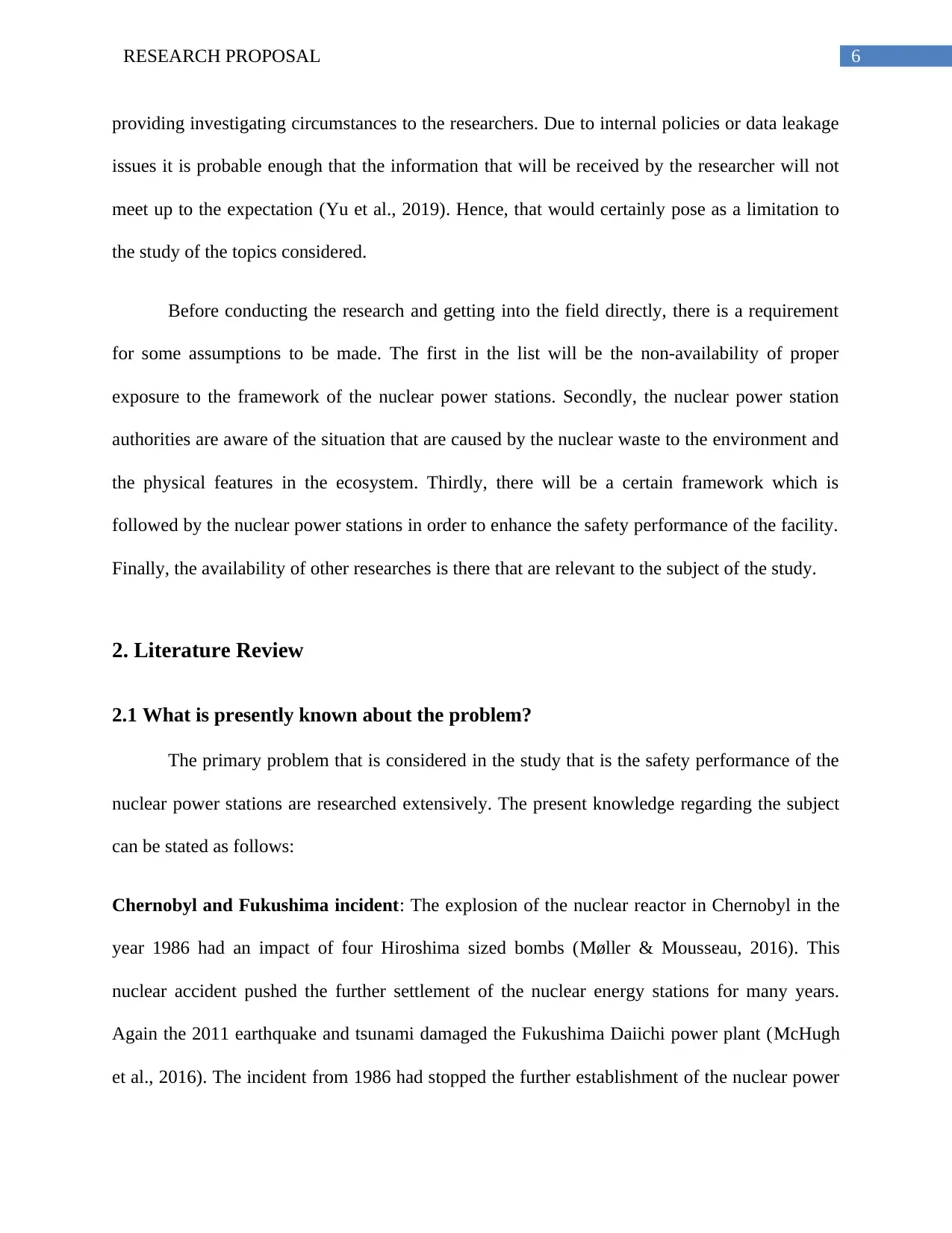
6RESEARCH PROPOSAL
providing investigating circumstances to the researchers. Due to internal policies or data leakage
issues it is probable enough that the information that will be received by the researcher will not
meet up to the expectation (Yu et al., 2019). Hence, that would certainly pose as a limitation to
the study of the topics considered.
Before conducting the research and getting into the field directly, there is a requirement
for some assumptions to be made. The first in the list will be the non-availability of proper
exposure to the framework of the nuclear power stations. Secondly, the nuclear power station
authorities are aware of the situation that are caused by the nuclear waste to the environment and
the physical features in the ecosystem. Thirdly, there will be a certain framework which is
followed by the nuclear power stations in order to enhance the safety performance of the facility.
Finally, the availability of other researches is there that are relevant to the subject of the study.
2. Literature Review
2.1 What is presently known about the problem?
The primary problem that is considered in the study that is the safety performance of the
nuclear power stations are researched extensively. The present knowledge regarding the subject
can be stated as follows:
Chernobyl and Fukushima incident: The explosion of the nuclear reactor in Chernobyl in the
year 1986 had an impact of four Hiroshima sized bombs (Møller & Mousseau, 2016). This
nuclear accident pushed the further settlement of the nuclear energy stations for many years.
Again the 2011 earthquake and tsunami damaged the Fukushima Daiichi power plant (McHugh
et al., 2016). The incident from 1986 had stopped the further establishment of the nuclear power
providing investigating circumstances to the researchers. Due to internal policies or data leakage
issues it is probable enough that the information that will be received by the researcher will not
meet up to the expectation (Yu et al., 2019). Hence, that would certainly pose as a limitation to
the study of the topics considered.
Before conducting the research and getting into the field directly, there is a requirement
for some assumptions to be made. The first in the list will be the non-availability of proper
exposure to the framework of the nuclear power stations. Secondly, the nuclear power station
authorities are aware of the situation that are caused by the nuclear waste to the environment and
the physical features in the ecosystem. Thirdly, there will be a certain framework which is
followed by the nuclear power stations in order to enhance the safety performance of the facility.
Finally, the availability of other researches is there that are relevant to the subject of the study.
2. Literature Review
2.1 What is presently known about the problem?
The primary problem that is considered in the study that is the safety performance of the
nuclear power stations are researched extensively. The present knowledge regarding the subject
can be stated as follows:
Chernobyl and Fukushima incident: The explosion of the nuclear reactor in Chernobyl in the
year 1986 had an impact of four Hiroshima sized bombs (Møller & Mousseau, 2016). This
nuclear accident pushed the further settlement of the nuclear energy stations for many years.
Again the 2011 earthquake and tsunami damaged the Fukushima Daiichi power plant (McHugh
et al., 2016). The incident from 1986 had stopped the further establishment of the nuclear power
Paraphrase This Document
Need a fresh take? Get an instant paraphrase of this document with our AI Paraphraser
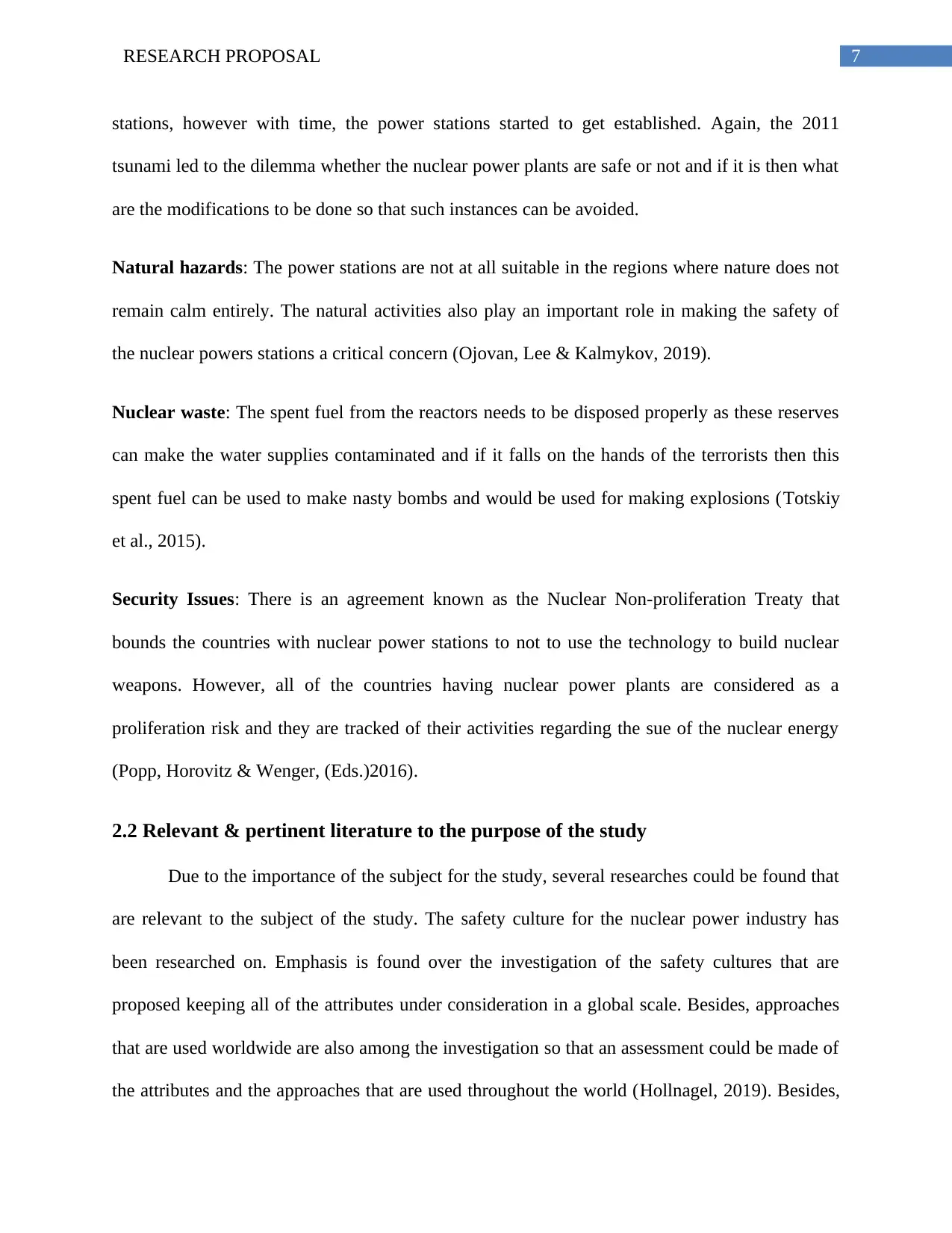
7RESEARCH PROPOSAL
stations, however with time, the power stations started to get established. Again, the 2011
tsunami led to the dilemma whether the nuclear power plants are safe or not and if it is then what
are the modifications to be done so that such instances can be avoided.
Natural hazards: The power stations are not at all suitable in the regions where nature does not
remain calm entirely. The natural activities also play an important role in making the safety of
the nuclear powers stations a critical concern (Ojovan, Lee & Kalmykov, 2019).
Nuclear waste: The spent fuel from the reactors needs to be disposed properly as these reserves
can make the water supplies contaminated and if it falls on the hands of the terrorists then this
spent fuel can be used to make nasty bombs and would be used for making explosions (Totskiy
et al., 2015).
Security Issues: There is an agreement known as the Nuclear Non-proliferation Treaty that
bounds the countries with nuclear power stations to not to use the technology to build nuclear
weapons. However, all of the countries having nuclear power plants are considered as a
proliferation risk and they are tracked of their activities regarding the sue of the nuclear energy
(Popp, Horovitz & Wenger, (Eds.)2016).
2.2 Relevant & pertinent literature to the purpose of the study
Due to the importance of the subject for the study, several researches could be found that
are relevant to the subject of the study. The safety culture for the nuclear power industry has
been researched on. Emphasis is found over the investigation of the safety cultures that are
proposed keeping all of the attributes under consideration in a global scale. Besides, approaches
that are used worldwide are also among the investigation so that an assessment could be made of
the attributes and the approaches that are used throughout the world (Hollnagel, 2019). Besides,
stations, however with time, the power stations started to get established. Again, the 2011
tsunami led to the dilemma whether the nuclear power plants are safe or not and if it is then what
are the modifications to be done so that such instances can be avoided.
Natural hazards: The power stations are not at all suitable in the regions where nature does not
remain calm entirely. The natural activities also play an important role in making the safety of
the nuclear powers stations a critical concern (Ojovan, Lee & Kalmykov, 2019).
Nuclear waste: The spent fuel from the reactors needs to be disposed properly as these reserves
can make the water supplies contaminated and if it falls on the hands of the terrorists then this
spent fuel can be used to make nasty bombs and would be used for making explosions (Totskiy
et al., 2015).
Security Issues: There is an agreement known as the Nuclear Non-proliferation Treaty that
bounds the countries with nuclear power stations to not to use the technology to build nuclear
weapons. However, all of the countries having nuclear power plants are considered as a
proliferation risk and they are tracked of their activities regarding the sue of the nuclear energy
(Popp, Horovitz & Wenger, (Eds.)2016).
2.2 Relevant & pertinent literature to the purpose of the study
Due to the importance of the subject for the study, several researches could be found that
are relevant to the subject of the study. The safety culture for the nuclear power industry has
been researched on. Emphasis is found over the investigation of the safety cultures that are
proposed keeping all of the attributes under consideration in a global scale. Besides, approaches
that are used worldwide are also among the investigation so that an assessment could be made of
the attributes and the approaches that are used throughout the world (Hollnagel, 2019). Besides,
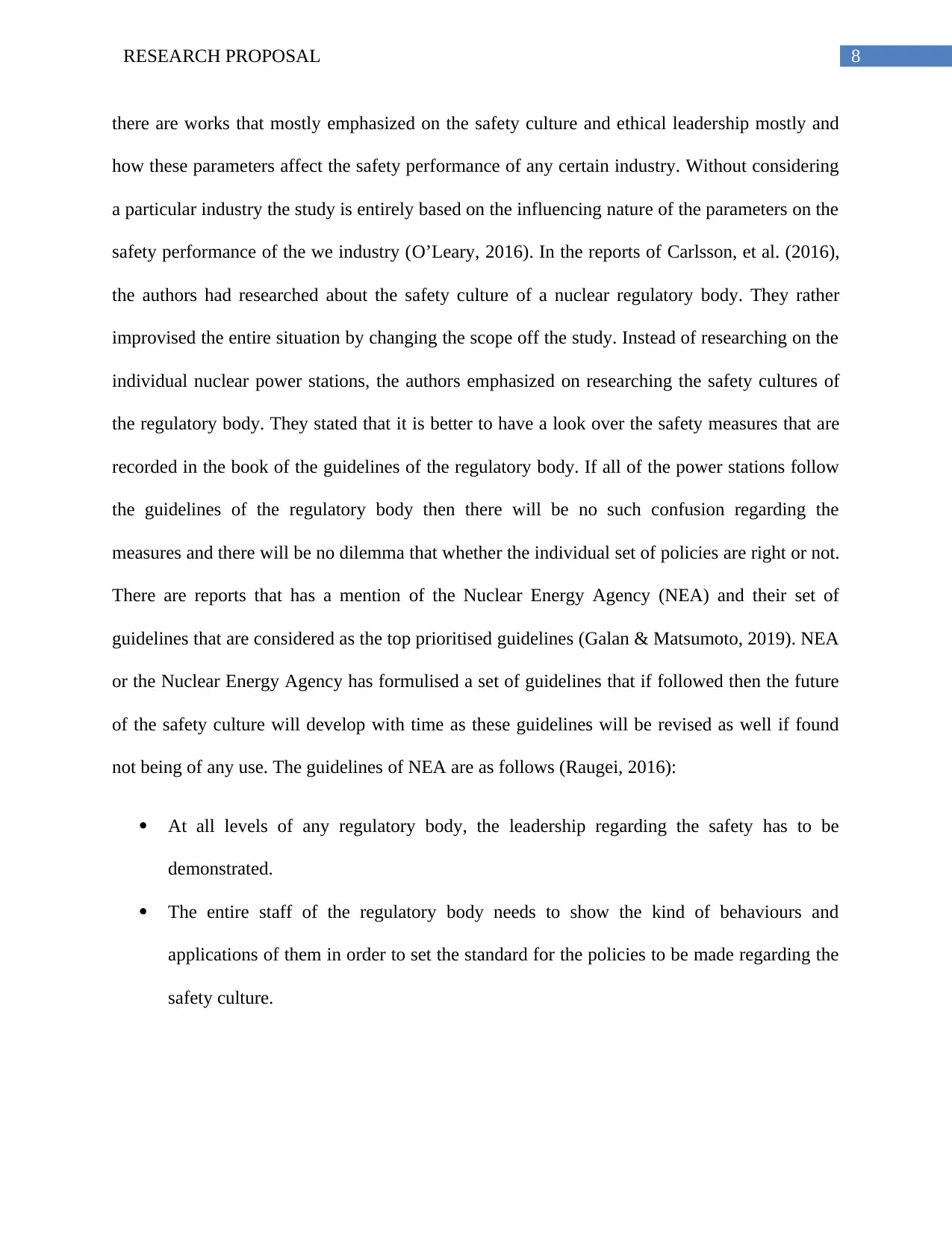
8RESEARCH PROPOSAL
there are works that mostly emphasized on the safety culture and ethical leadership mostly and
how these parameters affect the safety performance of any certain industry. Without considering
a particular industry the study is entirely based on the influencing nature of the parameters on the
safety performance of the we industry (O’Leary, 2016). In the reports of Carlsson, et al. (2016),
the authors had researched about the safety culture of a nuclear regulatory body. They rather
improvised the entire situation by changing the scope off the study. Instead of researching on the
individual nuclear power stations, the authors emphasized on researching the safety cultures of
the regulatory body. They stated that it is better to have a look over the safety measures that are
recorded in the book of the guidelines of the regulatory body. If all of the power stations follow
the guidelines of the regulatory body then there will be no such confusion regarding the
measures and there will be no dilemma that whether the individual set of policies are right or not.
There are reports that has a mention of the Nuclear Energy Agency (NEA) and their set of
guidelines that are considered as the top prioritised guidelines (Galan & Matsumoto, 2019). NEA
or the Nuclear Energy Agency has formulised a set of guidelines that if followed then the future
of the safety culture will develop with time as these guidelines will be revised as well if found
not being of any use. The guidelines of NEA are as follows (Raugei, 2016):
At all levels of any regulatory body, the leadership regarding the safety has to be
demonstrated.
The entire staff of the regulatory body needs to show the kind of behaviours and
applications of them in order to set the standard for the policies to be made regarding the
safety culture.
there are works that mostly emphasized on the safety culture and ethical leadership mostly and
how these parameters affect the safety performance of any certain industry. Without considering
a particular industry the study is entirely based on the influencing nature of the parameters on the
safety performance of the we industry (O’Leary, 2016). In the reports of Carlsson, et al. (2016),
the authors had researched about the safety culture of a nuclear regulatory body. They rather
improvised the entire situation by changing the scope off the study. Instead of researching on the
individual nuclear power stations, the authors emphasized on researching the safety cultures of
the regulatory body. They stated that it is better to have a look over the safety measures that are
recorded in the book of the guidelines of the regulatory body. If all of the power stations follow
the guidelines of the regulatory body then there will be no such confusion regarding the
measures and there will be no dilemma that whether the individual set of policies are right or not.
There are reports that has a mention of the Nuclear Energy Agency (NEA) and their set of
guidelines that are considered as the top prioritised guidelines (Galan & Matsumoto, 2019). NEA
or the Nuclear Energy Agency has formulised a set of guidelines that if followed then the future
of the safety culture will develop with time as these guidelines will be revised as well if found
not being of any use. The guidelines of NEA are as follows (Raugei, 2016):
At all levels of any regulatory body, the leadership regarding the safety has to be
demonstrated.
The entire staff of the regulatory body needs to show the kind of behaviours and
applications of them in order to set the standard for the policies to be made regarding the
safety culture.
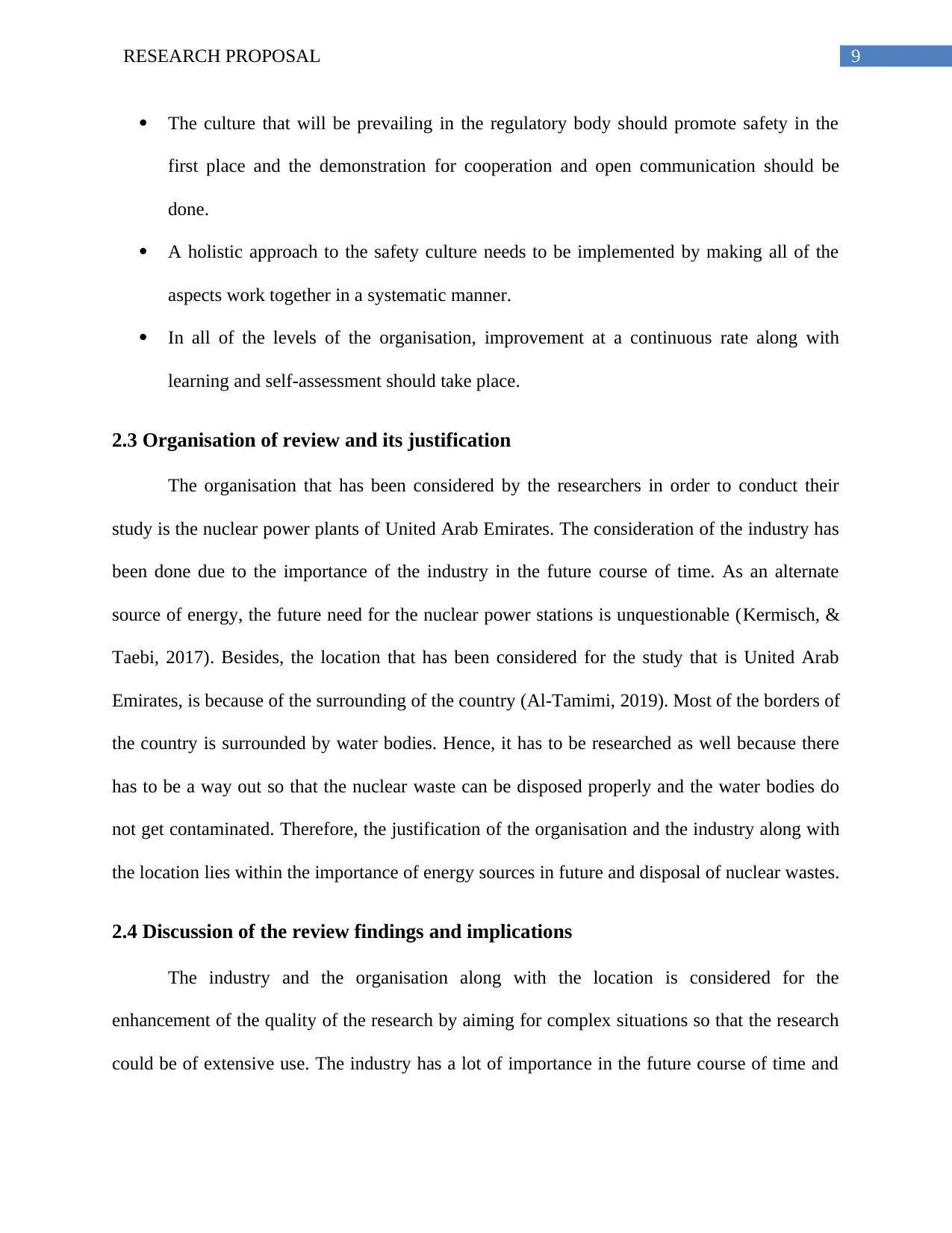
9RESEARCH PROPOSAL
The culture that will be prevailing in the regulatory body should promote safety in the
first place and the demonstration for cooperation and open communication should be
done.
A holistic approach to the safety culture needs to be implemented by making all of the
aspects work together in a systematic manner.
In all of the levels of the organisation, improvement at a continuous rate along with
learning and self-assessment should take place.
2.3 Organisation of review and its justification
The organisation that has been considered by the researchers in order to conduct their
study is the nuclear power plants of United Arab Emirates. The consideration of the industry has
been done due to the importance of the industry in the future course of time. As an alternate
source of energy, the future need for the nuclear power stations is unquestionable (Kermisch, &
Taebi, 2017). Besides, the location that has been considered for the study that is United Arab
Emirates, is because of the surrounding of the country (Al-Tamimi, 2019). Most of the borders of
the country is surrounded by water bodies. Hence, it has to be researched as well because there
has to be a way out so that the nuclear waste can be disposed properly and the water bodies do
not get contaminated. Therefore, the justification of the organisation and the industry along with
the location lies within the importance of energy sources in future and disposal of nuclear wastes.
2.4 Discussion of the review findings and implications
The industry and the organisation along with the location is considered for the
enhancement of the quality of the research by aiming for complex situations so that the research
could be of extensive use. The industry has a lot of importance in the future course of time and
The culture that will be prevailing in the regulatory body should promote safety in the
first place and the demonstration for cooperation and open communication should be
done.
A holistic approach to the safety culture needs to be implemented by making all of the
aspects work together in a systematic manner.
In all of the levels of the organisation, improvement at a continuous rate along with
learning and self-assessment should take place.
2.3 Organisation of review and its justification
The organisation that has been considered by the researchers in order to conduct their
study is the nuclear power plants of United Arab Emirates. The consideration of the industry has
been done due to the importance of the industry in the future course of time. As an alternate
source of energy, the future need for the nuclear power stations is unquestionable (Kermisch, &
Taebi, 2017). Besides, the location that has been considered for the study that is United Arab
Emirates, is because of the surrounding of the country (Al-Tamimi, 2019). Most of the borders of
the country is surrounded by water bodies. Hence, it has to be researched as well because there
has to be a way out so that the nuclear waste can be disposed properly and the water bodies do
not get contaminated. Therefore, the justification of the organisation and the industry along with
the location lies within the importance of energy sources in future and disposal of nuclear wastes.
2.4 Discussion of the review findings and implications
The industry and the organisation along with the location is considered for the
enhancement of the quality of the research by aiming for complex situations so that the research
could be of extensive use. The industry has a lot of importance in the future course of time and
Secure Best Marks with AI Grader
Need help grading? Try our AI Grader for instant feedback on your assignments.
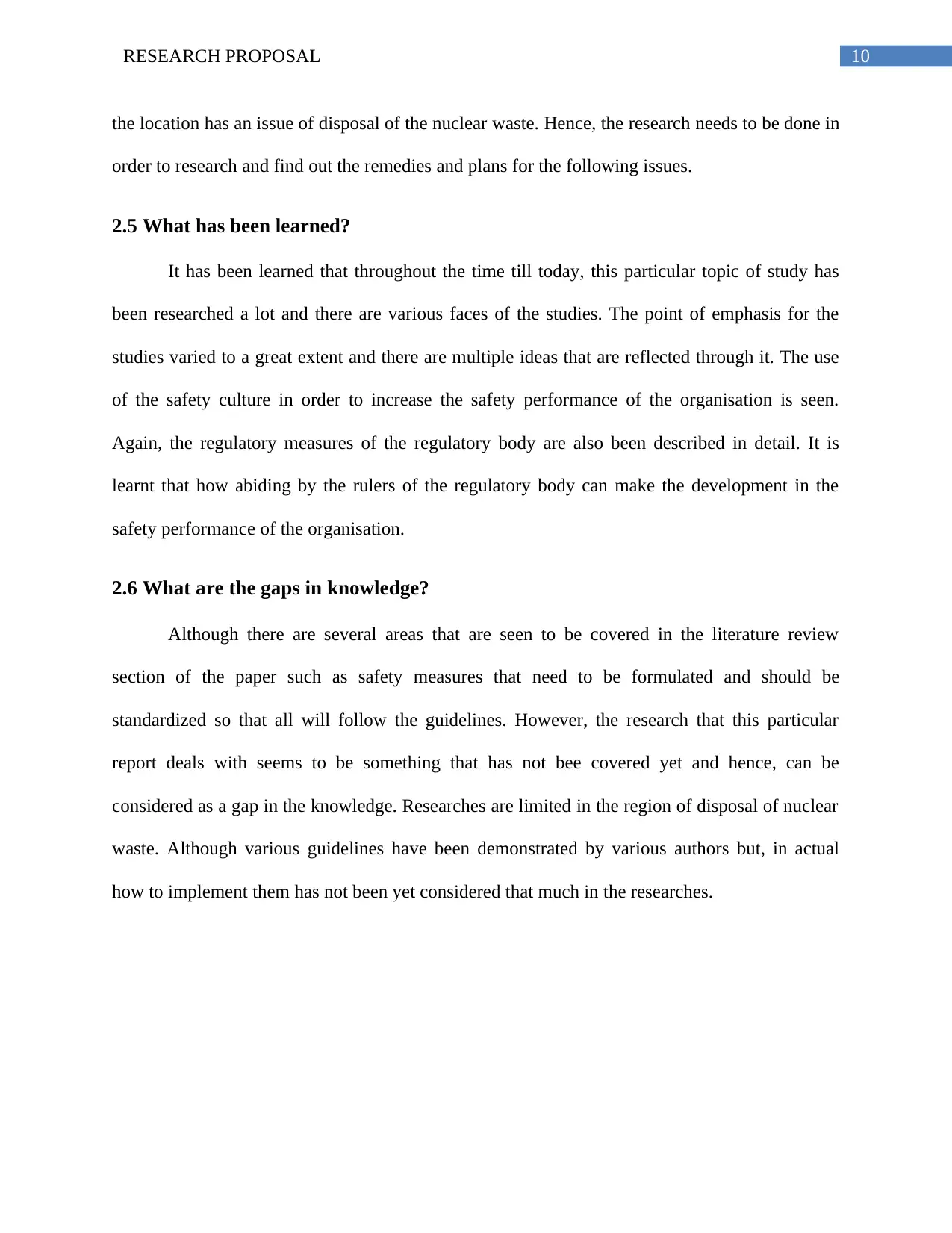
10RESEARCH PROPOSAL
the location has an issue of disposal of the nuclear waste. Hence, the research needs to be done in
order to research and find out the remedies and plans for the following issues.
2.5 What has been learned?
It has been learned that throughout the time till today, this particular topic of study has
been researched a lot and there are various faces of the studies. The point of emphasis for the
studies varied to a great extent and there are multiple ideas that are reflected through it. The use
of the safety culture in order to increase the safety performance of the organisation is seen.
Again, the regulatory measures of the regulatory body are also been described in detail. It is
learnt that how abiding by the rulers of the regulatory body can make the development in the
safety performance of the organisation.
2.6 What are the gaps in knowledge?
Although there are several areas that are seen to be covered in the literature review
section of the paper such as safety measures that need to be formulated and should be
standardized so that all will follow the guidelines. However, the research that this particular
report deals with seems to be something that has not bee covered yet and hence, can be
considered as a gap in the knowledge. Researches are limited in the region of disposal of nuclear
waste. Although various guidelines have been demonstrated by various authors but, in actual
how to implement them has not been yet considered that much in the researches.
the location has an issue of disposal of the nuclear waste. Hence, the research needs to be done in
order to research and find out the remedies and plans for the following issues.
2.5 What has been learned?
It has been learned that throughout the time till today, this particular topic of study has
been researched a lot and there are various faces of the studies. The point of emphasis for the
studies varied to a great extent and there are multiple ideas that are reflected through it. The use
of the safety culture in order to increase the safety performance of the organisation is seen.
Again, the regulatory measures of the regulatory body are also been described in detail. It is
learnt that how abiding by the rulers of the regulatory body can make the development in the
safety performance of the organisation.
2.6 What are the gaps in knowledge?
Although there are several areas that are seen to be covered in the literature review
section of the paper such as safety measures that need to be formulated and should be
standardized so that all will follow the guidelines. However, the research that this particular
report deals with seems to be something that has not bee covered yet and hence, can be
considered as a gap in the knowledge. Researches are limited in the region of disposal of nuclear
waste. Although various guidelines have been demonstrated by various authors but, in actual
how to implement them has not been yet considered that much in the researches.
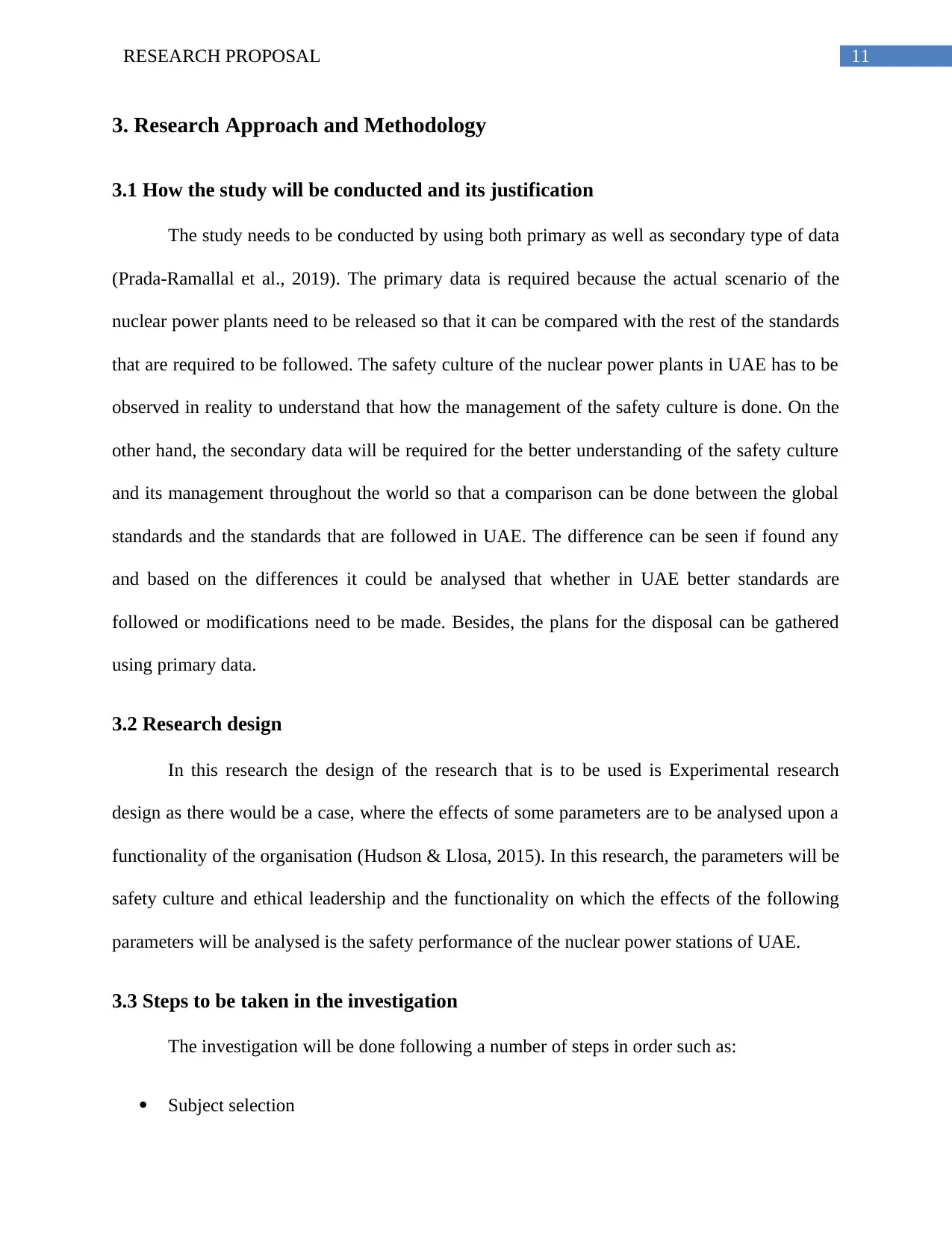
11RESEARCH PROPOSAL
3. Research Approach and Methodology
3.1 How the study will be conducted and its justification
The study needs to be conducted by using both primary as well as secondary type of data
(Prada-Ramallal et al., 2019). The primary data is required because the actual scenario of the
nuclear power plants need to be released so that it can be compared with the rest of the standards
that are required to be followed. The safety culture of the nuclear power plants in UAE has to be
observed in reality to understand that how the management of the safety culture is done. On the
other hand, the secondary data will be required for the better understanding of the safety culture
and its management throughout the world so that a comparison can be done between the global
standards and the standards that are followed in UAE. The difference can be seen if found any
and based on the differences it could be analysed that whether in UAE better standards are
followed or modifications need to be made. Besides, the plans for the disposal can be gathered
using primary data.
3.2 Research design
In this research the design of the research that is to be used is Experimental research
design as there would be a case, where the effects of some parameters are to be analysed upon a
functionality of the organisation (Hudson & Llosa, 2015). In this research, the parameters will be
safety culture and ethical leadership and the functionality on which the effects of the following
parameters will be analysed is the safety performance of the nuclear power stations of UAE.
3.3 Steps to be taken in the investigation
The investigation will be done following a number of steps in order such as:
Subject selection
3. Research Approach and Methodology
3.1 How the study will be conducted and its justification
The study needs to be conducted by using both primary as well as secondary type of data
(Prada-Ramallal et al., 2019). The primary data is required because the actual scenario of the
nuclear power plants need to be released so that it can be compared with the rest of the standards
that are required to be followed. The safety culture of the nuclear power plants in UAE has to be
observed in reality to understand that how the management of the safety culture is done. On the
other hand, the secondary data will be required for the better understanding of the safety culture
and its management throughout the world so that a comparison can be done between the global
standards and the standards that are followed in UAE. The difference can be seen if found any
and based on the differences it could be analysed that whether in UAE better standards are
followed or modifications need to be made. Besides, the plans for the disposal can be gathered
using primary data.
3.2 Research design
In this research the design of the research that is to be used is Experimental research
design as there would be a case, where the effects of some parameters are to be analysed upon a
functionality of the organisation (Hudson & Llosa, 2015). In this research, the parameters will be
safety culture and ethical leadership and the functionality on which the effects of the following
parameters will be analysed is the safety performance of the nuclear power stations of UAE.
3.3 Steps to be taken in the investigation
The investigation will be done following a number of steps in order such as:
Subject selection
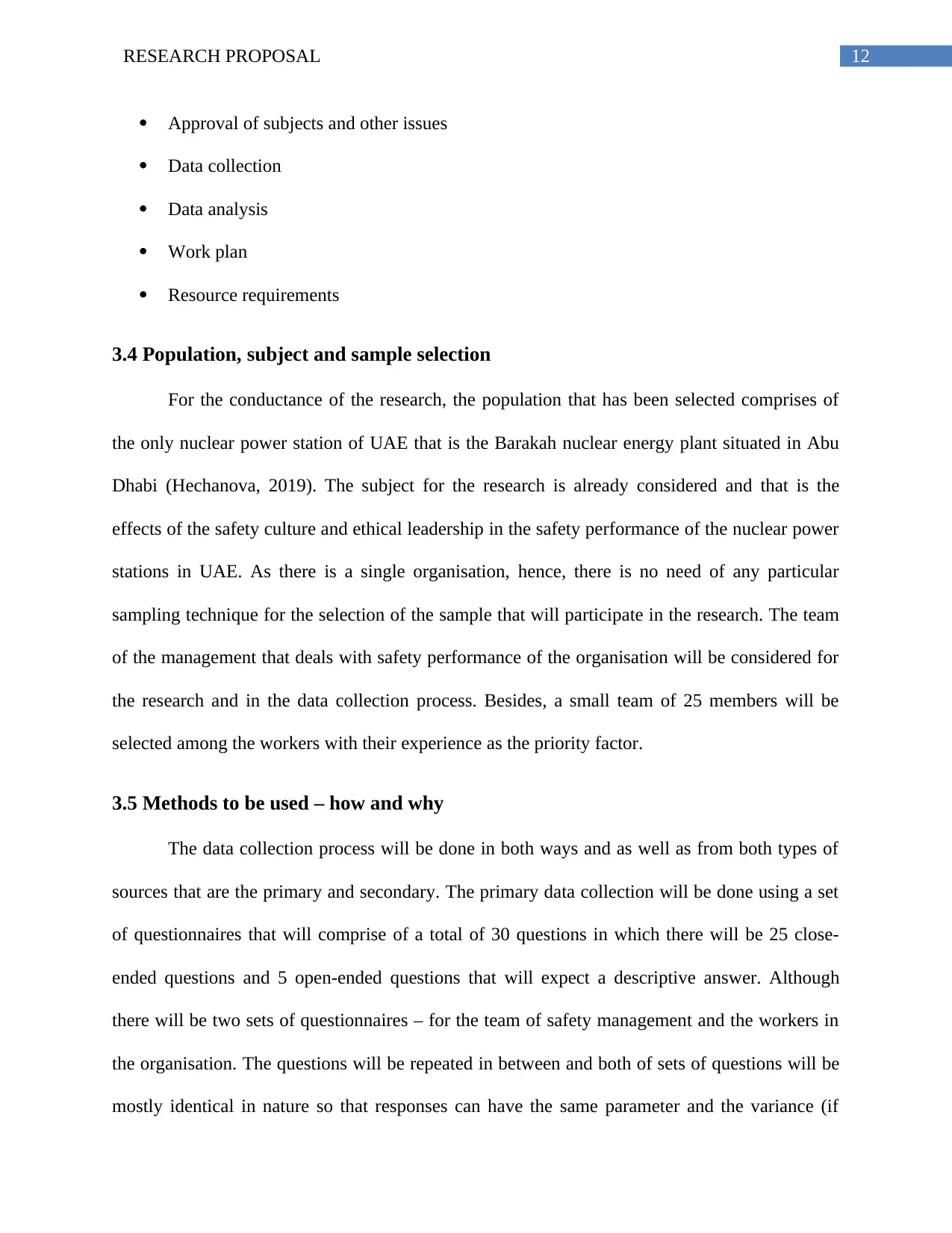
12RESEARCH PROPOSAL
Approval of subjects and other issues
Data collection
Data analysis
Work plan
Resource requirements
3.4 Population, subject and sample selection
For the conductance of the research, the population that has been selected comprises of
the only nuclear power station of UAE that is the Barakah nuclear energy plant situated in Abu
Dhabi (Hechanova, 2019). The subject for the research is already considered and that is the
effects of the safety culture and ethical leadership in the safety performance of the nuclear power
stations in UAE. As there is a single organisation, hence, there is no need of any particular
sampling technique for the selection of the sample that will participate in the research. The team
of the management that deals with safety performance of the organisation will be considered for
the research and in the data collection process. Besides, a small team of 25 members will be
selected among the workers with their experience as the priority factor.
3.5 Methods to be used – how and why
The data collection process will be done in both ways and as well as from both types of
sources that are the primary and secondary. The primary data collection will be done using a set
of questionnaires that will comprise of a total of 30 questions in which there will be 25 close-
ended questions and 5 open-ended questions that will expect a descriptive answer. Although
there will be two sets of questionnaires – for the team of safety management and the workers in
the organisation. The questions will be repeated in between and both of sets of questions will be
mostly identical in nature so that responses can have the same parameter and the variance (if
Approval of subjects and other issues
Data collection
Data analysis
Work plan
Resource requirements
3.4 Population, subject and sample selection
For the conductance of the research, the population that has been selected comprises of
the only nuclear power station of UAE that is the Barakah nuclear energy plant situated in Abu
Dhabi (Hechanova, 2019). The subject for the research is already considered and that is the
effects of the safety culture and ethical leadership in the safety performance of the nuclear power
stations in UAE. As there is a single organisation, hence, there is no need of any particular
sampling technique for the selection of the sample that will participate in the research. The team
of the management that deals with safety performance of the organisation will be considered for
the research and in the data collection process. Besides, a small team of 25 members will be
selected among the workers with their experience as the priority factor.
3.5 Methods to be used – how and why
The data collection process will be done in both ways and as well as from both types of
sources that are the primary and secondary. The primary data collection will be done using a set
of questionnaires that will comprise of a total of 30 questions in which there will be 25 close-
ended questions and 5 open-ended questions that will expect a descriptive answer. Although
there will be two sets of questionnaires – for the team of safety management and the workers in
the organisation. The questions will be repeated in between and both of sets of questions will be
mostly identical in nature so that responses can have the same parameter and the variance (if
Paraphrase This Document
Need a fresh take? Get an instant paraphrase of this document with our AI Paraphraser
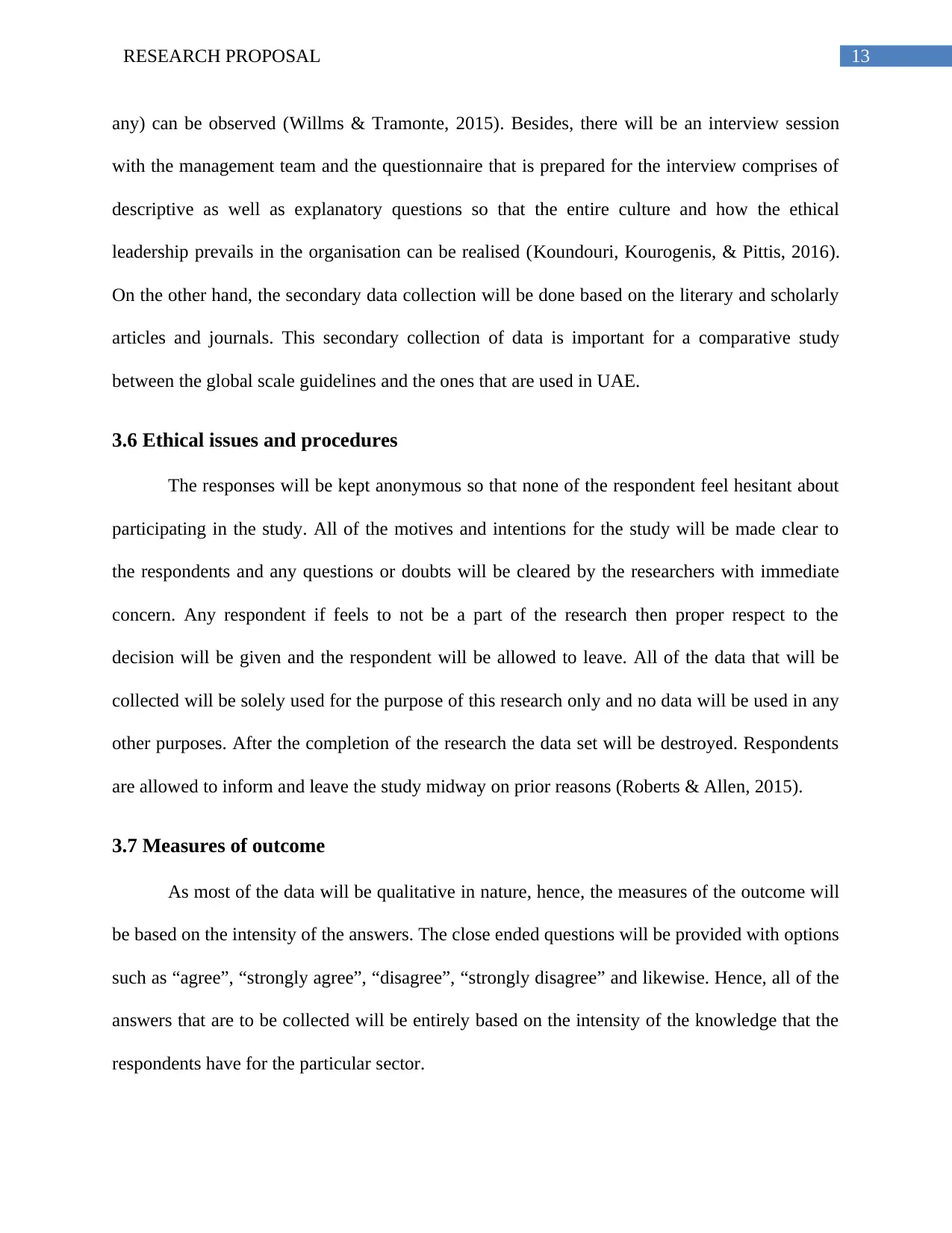
13RESEARCH PROPOSAL
any) can be observed (Willms & Tramonte, 2015). Besides, there will be an interview session
with the management team and the questionnaire that is prepared for the interview comprises of
descriptive as well as explanatory questions so that the entire culture and how the ethical
leadership prevails in the organisation can be realised (Koundouri, Kourogenis, & Pittis, 2016).
On the other hand, the secondary data collection will be done based on the literary and scholarly
articles and journals. This secondary collection of data is important for a comparative study
between the global scale guidelines and the ones that are used in UAE.
3.6 Ethical issues and procedures
The responses will be kept anonymous so that none of the respondent feel hesitant about
participating in the study. All of the motives and intentions for the study will be made clear to
the respondents and any questions or doubts will be cleared by the researchers with immediate
concern. Any respondent if feels to not be a part of the research then proper respect to the
decision will be given and the respondent will be allowed to leave. All of the data that will be
collected will be solely used for the purpose of this research only and no data will be used in any
other purposes. After the completion of the research the data set will be destroyed. Respondents
are allowed to inform and leave the study midway on prior reasons (Roberts & Allen, 2015).
3.7 Measures of outcome
As most of the data will be qualitative in nature, hence, the measures of the outcome will
be based on the intensity of the answers. The close ended questions will be provided with options
such as “agree”, “strongly agree”, “disagree”, “strongly disagree” and likewise. Hence, all of the
answers that are to be collected will be entirely based on the intensity of the knowledge that the
respondents have for the particular sector.
any) can be observed (Willms & Tramonte, 2015). Besides, there will be an interview session
with the management team and the questionnaire that is prepared for the interview comprises of
descriptive as well as explanatory questions so that the entire culture and how the ethical
leadership prevails in the organisation can be realised (Koundouri, Kourogenis, & Pittis, 2016).
On the other hand, the secondary data collection will be done based on the literary and scholarly
articles and journals. This secondary collection of data is important for a comparative study
between the global scale guidelines and the ones that are used in UAE.
3.6 Ethical issues and procedures
The responses will be kept anonymous so that none of the respondent feel hesitant about
participating in the study. All of the motives and intentions for the study will be made clear to
the respondents and any questions or doubts will be cleared by the researchers with immediate
concern. Any respondent if feels to not be a part of the research then proper respect to the
decision will be given and the respondent will be allowed to leave. All of the data that will be
collected will be solely used for the purpose of this research only and no data will be used in any
other purposes. After the completion of the research the data set will be destroyed. Respondents
are allowed to inform and leave the study midway on prior reasons (Roberts & Allen, 2015).
3.7 Measures of outcome
As most of the data will be qualitative in nature, hence, the measures of the outcome will
be based on the intensity of the answers. The close ended questions will be provided with options
such as “agree”, “strongly agree”, “disagree”, “strongly disagree” and likewise. Hence, all of the
answers that are to be collected will be entirely based on the intensity of the knowledge that the
respondents have for the particular sector.
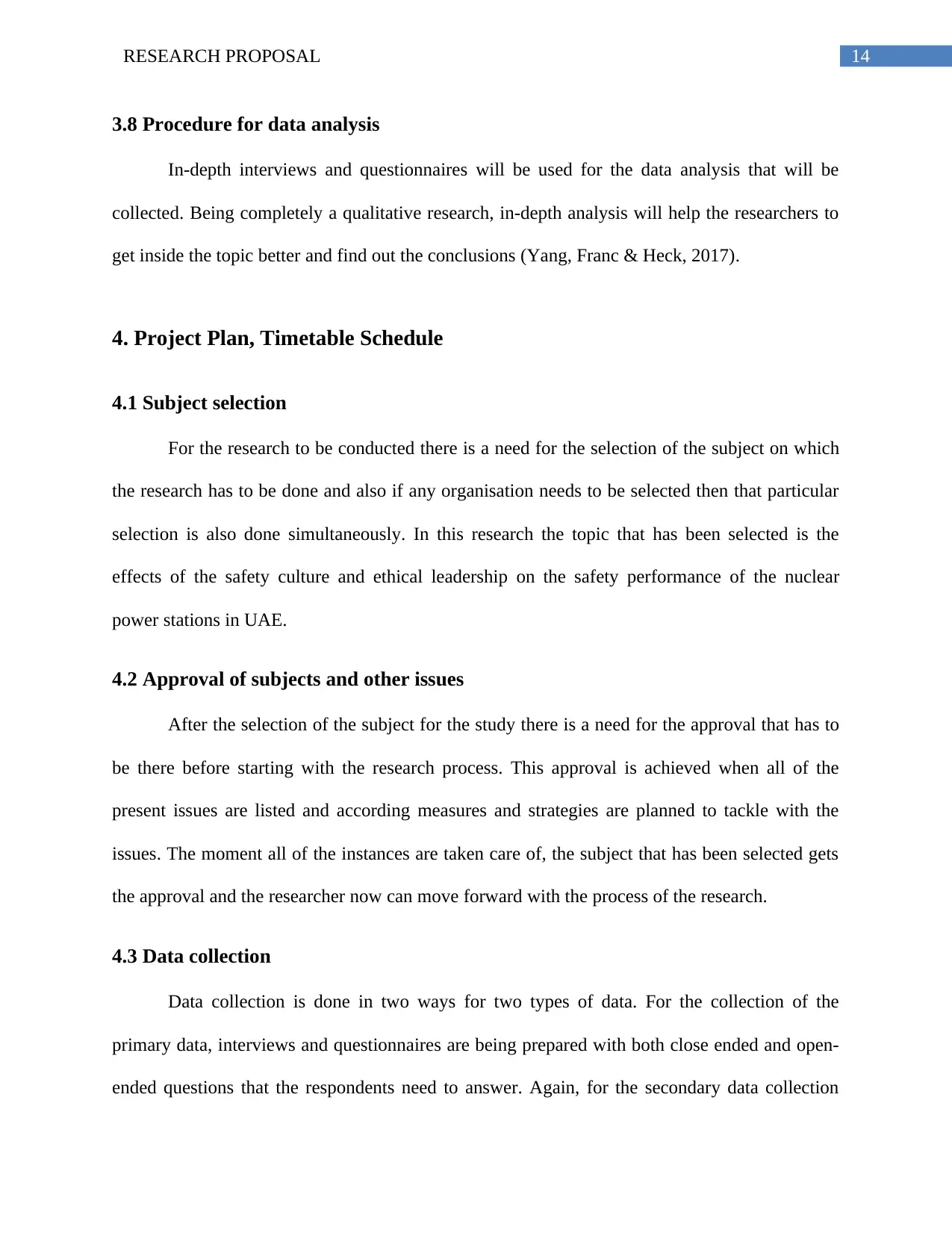
14RESEARCH PROPOSAL
3.8 Procedure for data analysis
In-depth interviews and questionnaires will be used for the data analysis that will be
collected. Being completely a qualitative research, in-depth analysis will help the researchers to
get inside the topic better and find out the conclusions (Yang, Franc & Heck, 2017).
4. Project Plan, Timetable Schedule
4.1 Subject selection
For the research to be conducted there is a need for the selection of the subject on which
the research has to be done and also if any organisation needs to be selected then that particular
selection is also done simultaneously. In this research the topic that has been selected is the
effects of the safety culture and ethical leadership on the safety performance of the nuclear
power stations in UAE.
4.2 Approval of subjects and other issues
After the selection of the subject for the study there is a need for the approval that has to
be there before starting with the research process. This approval is achieved when all of the
present issues are listed and according measures and strategies are planned to tackle with the
issues. The moment all of the instances are taken care of, the subject that has been selected gets
the approval and the researcher now can move forward with the process of the research.
4.3 Data collection
Data collection is done in two ways for two types of data. For the collection of the
primary data, interviews and questionnaires are being prepared with both close ended and open-
ended questions that the respondents need to answer. Again, for the secondary data collection
3.8 Procedure for data analysis
In-depth interviews and questionnaires will be used for the data analysis that will be
collected. Being completely a qualitative research, in-depth analysis will help the researchers to
get inside the topic better and find out the conclusions (Yang, Franc & Heck, 2017).
4. Project Plan, Timetable Schedule
4.1 Subject selection
For the research to be conducted there is a need for the selection of the subject on which
the research has to be done and also if any organisation needs to be selected then that particular
selection is also done simultaneously. In this research the topic that has been selected is the
effects of the safety culture and ethical leadership on the safety performance of the nuclear
power stations in UAE.
4.2 Approval of subjects and other issues
After the selection of the subject for the study there is a need for the approval that has to
be there before starting with the research process. This approval is achieved when all of the
present issues are listed and according measures and strategies are planned to tackle with the
issues. The moment all of the instances are taken care of, the subject that has been selected gets
the approval and the researcher now can move forward with the process of the research.
4.3 Data collection
Data collection is done in two ways for two types of data. For the collection of the
primary data, interviews and questionnaires are being prepared with both close ended and open-
ended questions that the respondents need to answer. Again, for the secondary data collection
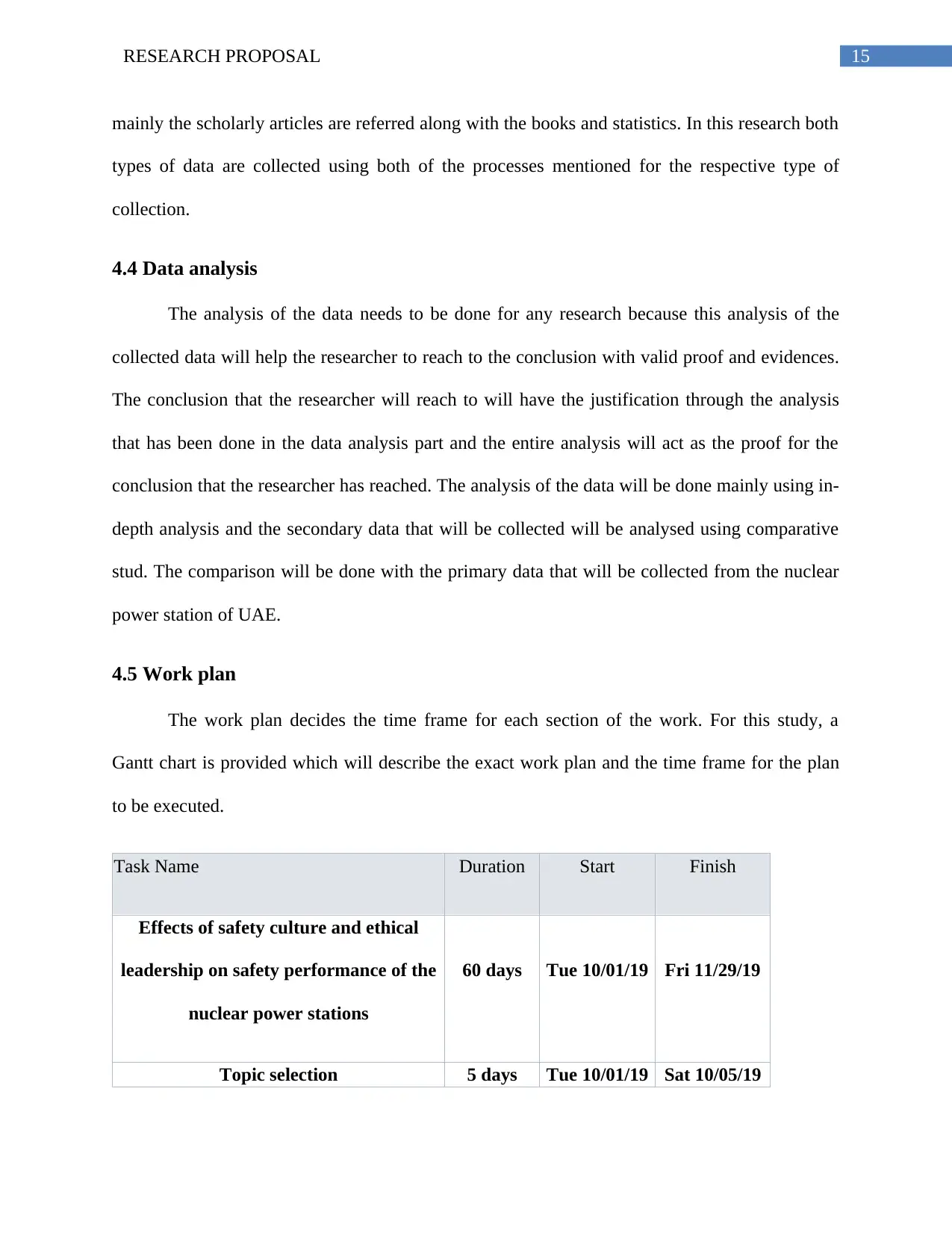
15RESEARCH PROPOSAL
mainly the scholarly articles are referred along with the books and statistics. In this research both
types of data are collected using both of the processes mentioned for the respective type of
collection.
4.4 Data analysis
The analysis of the data needs to be done for any research because this analysis of the
collected data will help the researcher to reach to the conclusion with valid proof and evidences.
The conclusion that the researcher will reach to will have the justification through the analysis
that has been done in the data analysis part and the entire analysis will act as the proof for the
conclusion that the researcher has reached. The analysis of the data will be done mainly using in-
depth analysis and the secondary data that will be collected will be analysed using comparative
stud. The comparison will be done with the primary data that will be collected from the nuclear
power station of UAE.
4.5 Work plan
The work plan decides the time frame for each section of the work. For this study, a
Gantt chart is provided which will describe the exact work plan and the time frame for the plan
to be executed.
Task Name Duration Start Finish
Effects of safety culture and ethical
leadership on safety performance of the
nuclear power stations
60 days Tue 10/01/19 Fri 11/29/19
Topic selection 5 days Tue 10/01/19 Sat 10/05/19
mainly the scholarly articles are referred along with the books and statistics. In this research both
types of data are collected using both of the processes mentioned for the respective type of
collection.
4.4 Data analysis
The analysis of the data needs to be done for any research because this analysis of the
collected data will help the researcher to reach to the conclusion with valid proof and evidences.
The conclusion that the researcher will reach to will have the justification through the analysis
that has been done in the data analysis part and the entire analysis will act as the proof for the
conclusion that the researcher has reached. The analysis of the data will be done mainly using in-
depth analysis and the secondary data that will be collected will be analysed using comparative
stud. The comparison will be done with the primary data that will be collected from the nuclear
power station of UAE.
4.5 Work plan
The work plan decides the time frame for each section of the work. For this study, a
Gantt chart is provided which will describe the exact work plan and the time frame for the plan
to be executed.
Task Name Duration Start Finish
Effects of safety culture and ethical
leadership on safety performance of the
nuclear power stations
60 days Tue 10/01/19 Fri 11/29/19
Topic selection 5 days Tue 10/01/19 Sat 10/05/19
Secure Best Marks with AI Grader
Need help grading? Try our AI Grader for instant feedback on your assignments.
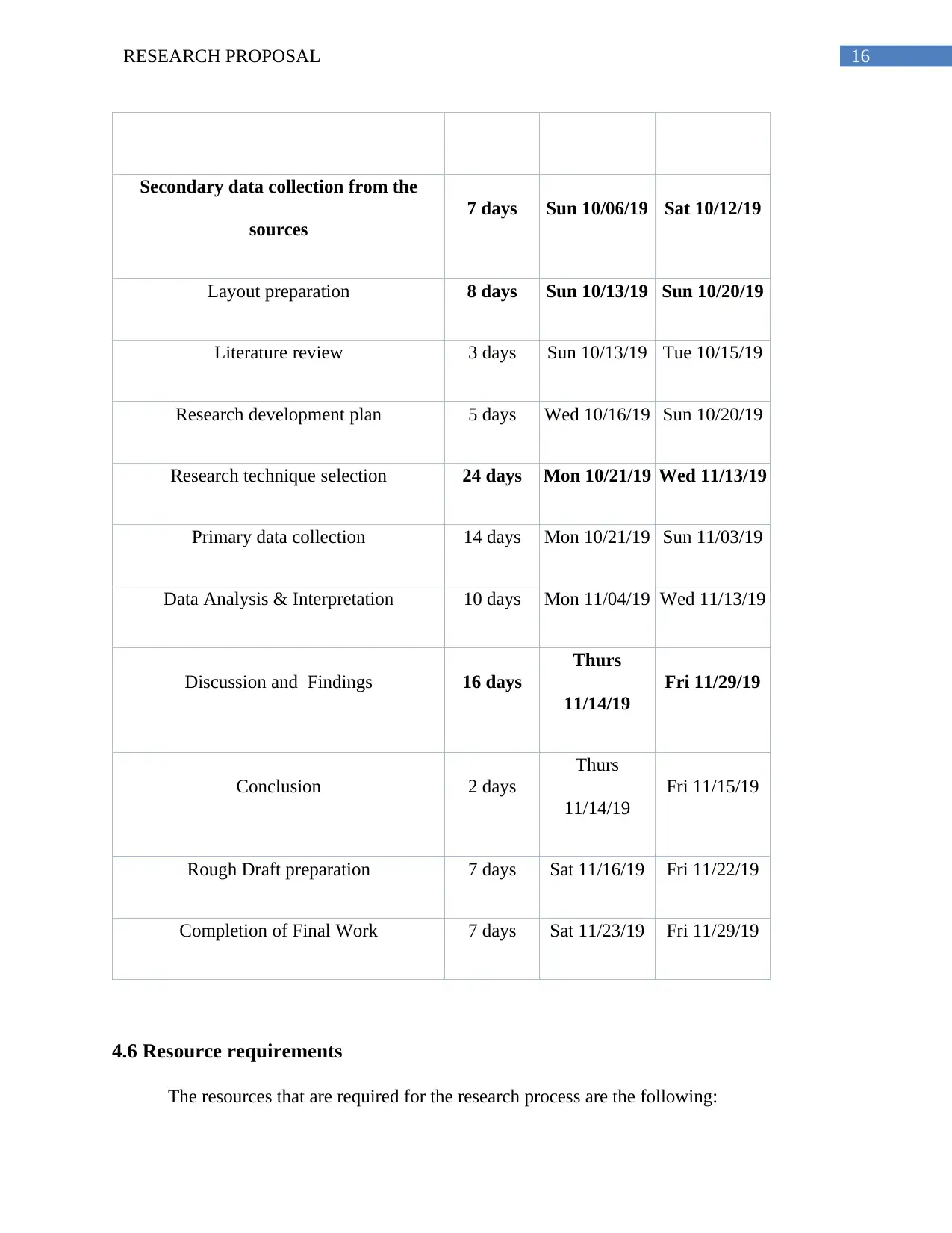
16RESEARCH PROPOSAL
Secondary data collection from the
sources
7 days Sun 10/06/19 Sat 10/12/19
Layout preparation 8 days Sun 10/13/19 Sun 10/20/19
Literature review 3 days Sun 10/13/19 Tue 10/15/19
Research development plan 5 days Wed 10/16/19 Sun 10/20/19
Research technique selection 24 days Mon 10/21/19 Wed 11/13/19
Primary data collection 14 days Mon 10/21/19 Sun 11/03/19
Data Analysis & Interpretation 10 days Mon 11/04/19 Wed 11/13/19
Discussion and Findings 16 days
Thurs
11/14/19
Fri 11/29/19
Conclusion 2 days
Thurs
11/14/19
Fri 11/15/19
Rough Draft preparation 7 days Sat 11/16/19 Fri 11/22/19
Completion of Final Work 7 days Sat 11/23/19 Fri 11/29/19
4.6 Resource requirements
The resources that are required for the research process are the following:
Secondary data collection from the
sources
7 days Sun 10/06/19 Sat 10/12/19
Layout preparation 8 days Sun 10/13/19 Sun 10/20/19
Literature review 3 days Sun 10/13/19 Tue 10/15/19
Research development plan 5 days Wed 10/16/19 Sun 10/20/19
Research technique selection 24 days Mon 10/21/19 Wed 11/13/19
Primary data collection 14 days Mon 10/21/19 Sun 11/03/19
Data Analysis & Interpretation 10 days Mon 11/04/19 Wed 11/13/19
Discussion and Findings 16 days
Thurs
11/14/19
Fri 11/29/19
Conclusion 2 days
Thurs
11/14/19
Fri 11/15/19
Rough Draft preparation 7 days Sat 11/16/19 Fri 11/22/19
Completion of Final Work 7 days Sat 11/23/19 Fri 11/29/19
4.6 Resource requirements
The resources that are required for the research process are the following:
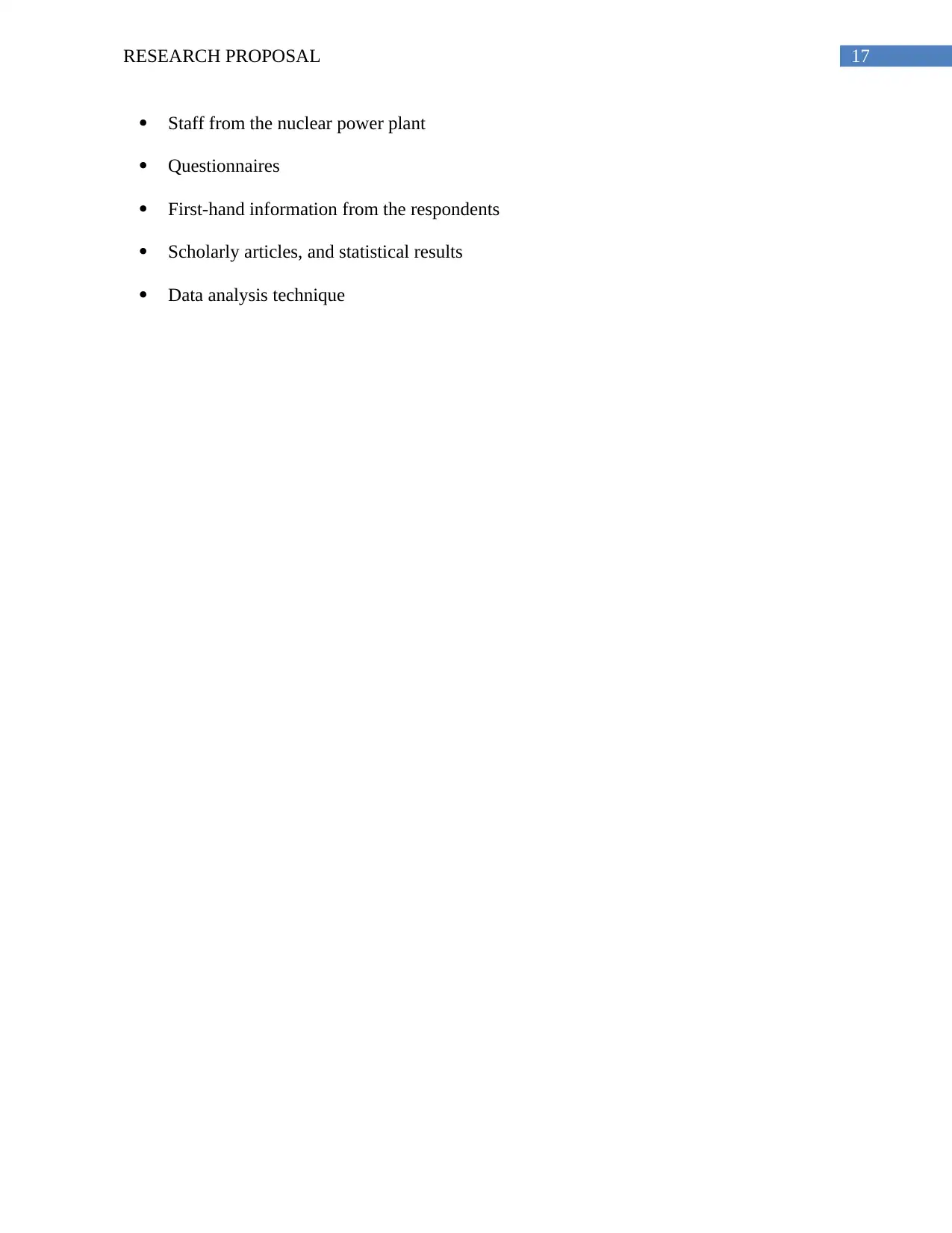
17RESEARCH PROPOSAL
Staff from the nuclear power plant
Questionnaires
First-hand information from the respondents
Scholarly articles, and statistical results
Data analysis technique
Staff from the nuclear power plant
Questionnaires
First-hand information from the respondents
Scholarly articles, and statistical results
Data analysis technique
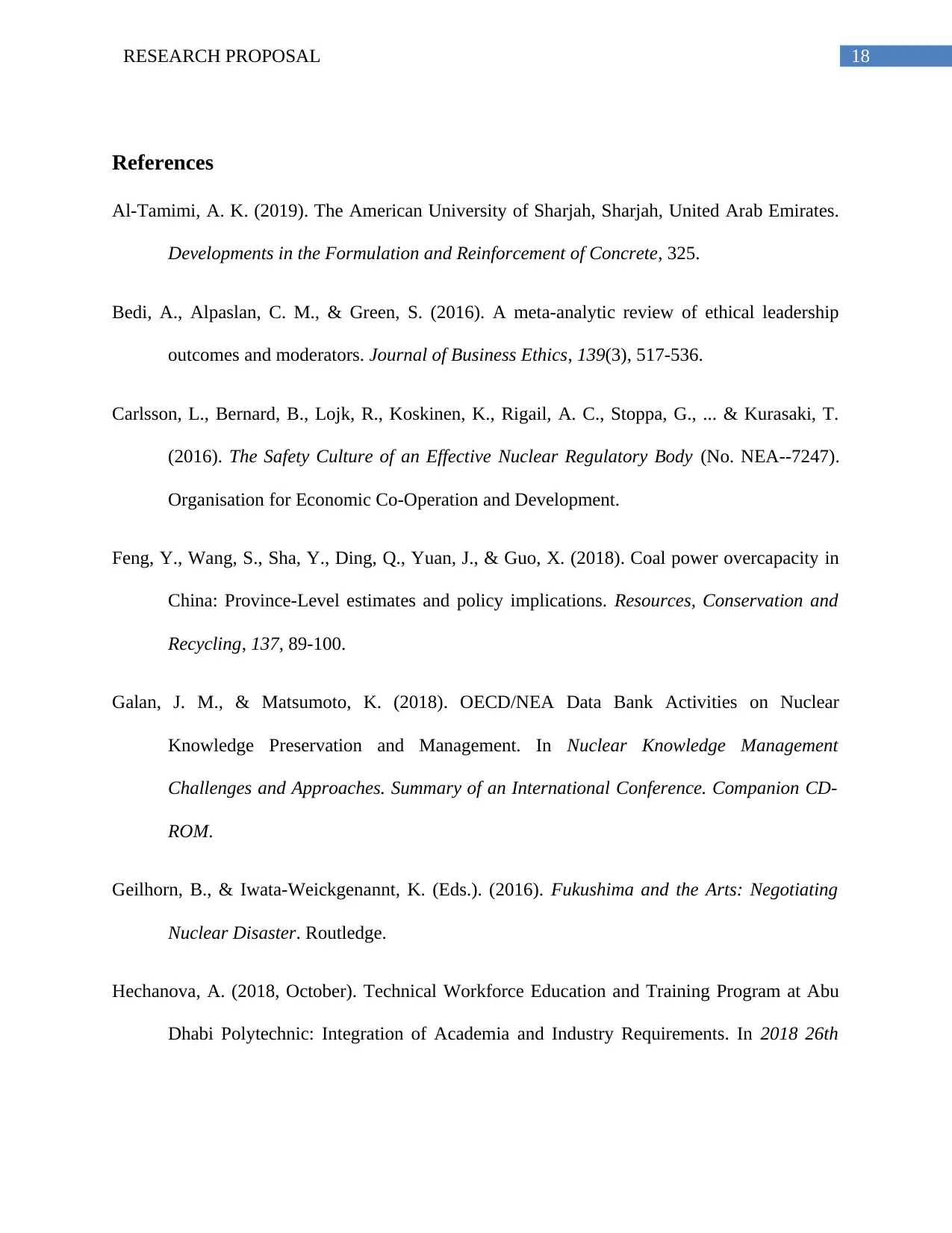
18RESEARCH PROPOSAL
References
Al-Tamimi, A. K. (2019). The American University of Sharjah, Sharjah, United Arab Emirates.
Developments in the Formulation and Reinforcement of Concrete, 325.
Bedi, A., Alpaslan, C. M., & Green, S. (2016). A meta-analytic review of ethical leadership
outcomes and moderators. Journal of Business Ethics, 139(3), 517-536.
Carlsson, L., Bernard, B., Lojk, R., Koskinen, K., Rigail, A. C., Stoppa, G., ... & Kurasaki, T.
(2016). The Safety Culture of an Effective Nuclear Regulatory Body (No. NEA--7247).
Organisation for Economic Co-Operation and Development.
Feng, Y., Wang, S., Sha, Y., Ding, Q., Yuan, J., & Guo, X. (2018). Coal power overcapacity in
China: Province-Level estimates and policy implications. Resources, Conservation and
Recycling, 137, 89-100.
Galan, J. M., & Matsumoto, K. (2018). OECD/NEA Data Bank Activities on Nuclear
Knowledge Preservation and Management. In Nuclear Knowledge Management
Challenges and Approaches. Summary of an International Conference. Companion CD-
ROM.
Geilhorn, B., & Iwata-Weickgenannt, K. (Eds.). (2016). Fukushima and the Arts: Negotiating
Nuclear Disaster. Routledge.
Hechanova, A. (2018, October). Technical Workforce Education and Training Program at Abu
Dhabi Polytechnic: Integration of Academia and Industry Requirements. In 2018 26th
References
Al-Tamimi, A. K. (2019). The American University of Sharjah, Sharjah, United Arab Emirates.
Developments in the Formulation and Reinforcement of Concrete, 325.
Bedi, A., Alpaslan, C. M., & Green, S. (2016). A meta-analytic review of ethical leadership
outcomes and moderators. Journal of Business Ethics, 139(3), 517-536.
Carlsson, L., Bernard, B., Lojk, R., Koskinen, K., Rigail, A. C., Stoppa, G., ... & Kurasaki, T.
(2016). The Safety Culture of an Effective Nuclear Regulatory Body (No. NEA--7247).
Organisation for Economic Co-Operation and Development.
Feng, Y., Wang, S., Sha, Y., Ding, Q., Yuan, J., & Guo, X. (2018). Coal power overcapacity in
China: Province-Level estimates and policy implications. Resources, Conservation and
Recycling, 137, 89-100.
Galan, J. M., & Matsumoto, K. (2018). OECD/NEA Data Bank Activities on Nuclear
Knowledge Preservation and Management. In Nuclear Knowledge Management
Challenges and Approaches. Summary of an International Conference. Companion CD-
ROM.
Geilhorn, B., & Iwata-Weickgenannt, K. (Eds.). (2016). Fukushima and the Arts: Negotiating
Nuclear Disaster. Routledge.
Hechanova, A. (2018, October). Technical Workforce Education and Training Program at Abu
Dhabi Polytechnic: Integration of Academia and Industry Requirements. In 2018 26th
Paraphrase This Document
Need a fresh take? Get an instant paraphrase of this document with our AI Paraphraser
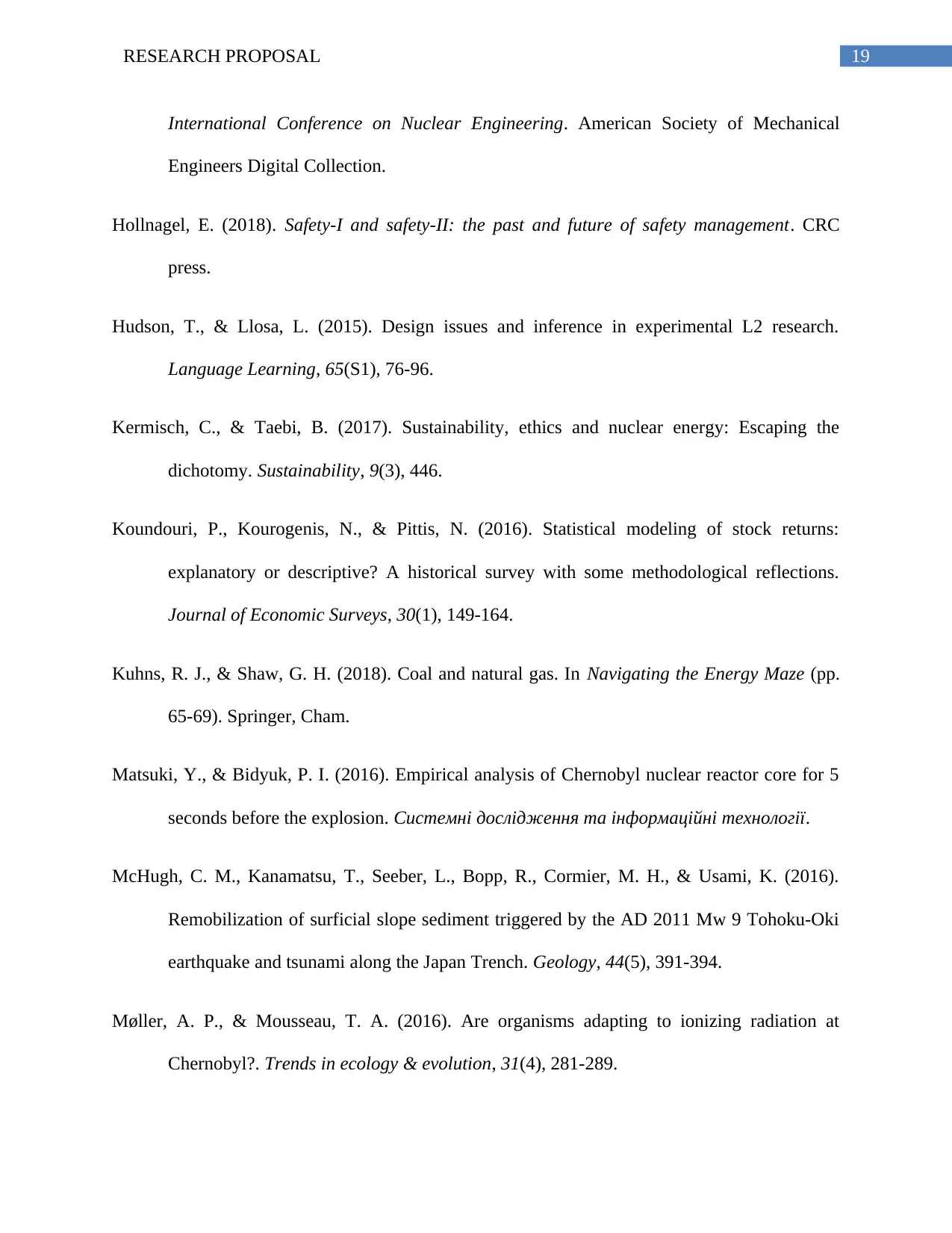
19RESEARCH PROPOSAL
International Conference on Nuclear Engineering. American Society of Mechanical
Engineers Digital Collection.
Hollnagel, E. (2018). Safety-I and safety-II: the past and future of safety management. CRC
press.
Hudson, T., & Llosa, L. (2015). Design issues and inference in experimental L2 research.
Language Learning, 65(S1), 76-96.
Kermisch, C., & Taebi, B. (2017). Sustainability, ethics and nuclear energy: Escaping the
dichotomy. Sustainability, 9(3), 446.
Koundouri, P., Kourogenis, N., & Pittis, N. (2016). Statistical modeling of stock returns:
explanatory or descriptive? A historical survey with some methodological reflections.
Journal of Economic Surveys, 30(1), 149-164.
Kuhns, R. J., & Shaw, G. H. (2018). Coal and natural gas. In Navigating the Energy Maze (pp.
65-69). Springer, Cham.
Matsuki, Y., & Bidyuk, P. I. (2016). Empirical analysis of Chernobyl nuclear reactor core for 5
seconds before the explosion. Системні дослідження та інформаційні технології.
McHugh, C. M., Kanamatsu, T., Seeber, L., Bopp, R., Cormier, M. H., & Usami, K. (2016).
Remobilization of surficial slope sediment triggered by the AD 2011 Mw 9 Tohoku-Oki
earthquake and tsunami along the Japan Trench. Geology, 44(5), 391-394.
Møller, A. P., & Mousseau, T. A. (2016). Are organisms adapting to ionizing radiation at
Chernobyl?. Trends in ecology & evolution, 31(4), 281-289.
International Conference on Nuclear Engineering. American Society of Mechanical
Engineers Digital Collection.
Hollnagel, E. (2018). Safety-I and safety-II: the past and future of safety management. CRC
press.
Hudson, T., & Llosa, L. (2015). Design issues and inference in experimental L2 research.
Language Learning, 65(S1), 76-96.
Kermisch, C., & Taebi, B. (2017). Sustainability, ethics and nuclear energy: Escaping the
dichotomy. Sustainability, 9(3), 446.
Koundouri, P., Kourogenis, N., & Pittis, N. (2016). Statistical modeling of stock returns:
explanatory or descriptive? A historical survey with some methodological reflections.
Journal of Economic Surveys, 30(1), 149-164.
Kuhns, R. J., & Shaw, G. H. (2018). Coal and natural gas. In Navigating the Energy Maze (pp.
65-69). Springer, Cham.
Matsuki, Y., & Bidyuk, P. I. (2016). Empirical analysis of Chernobyl nuclear reactor core for 5
seconds before the explosion. Системні дослідження та інформаційні технології.
McHugh, C. M., Kanamatsu, T., Seeber, L., Bopp, R., Cormier, M. H., & Usami, K. (2016).
Remobilization of surficial slope sediment triggered by the AD 2011 Mw 9 Tohoku-Oki
earthquake and tsunami along the Japan Trench. Geology, 44(5), 391-394.
Møller, A. P., & Mousseau, T. A. (2016). Are organisms adapting to ionizing radiation at
Chernobyl?. Trends in ecology & evolution, 31(4), 281-289.
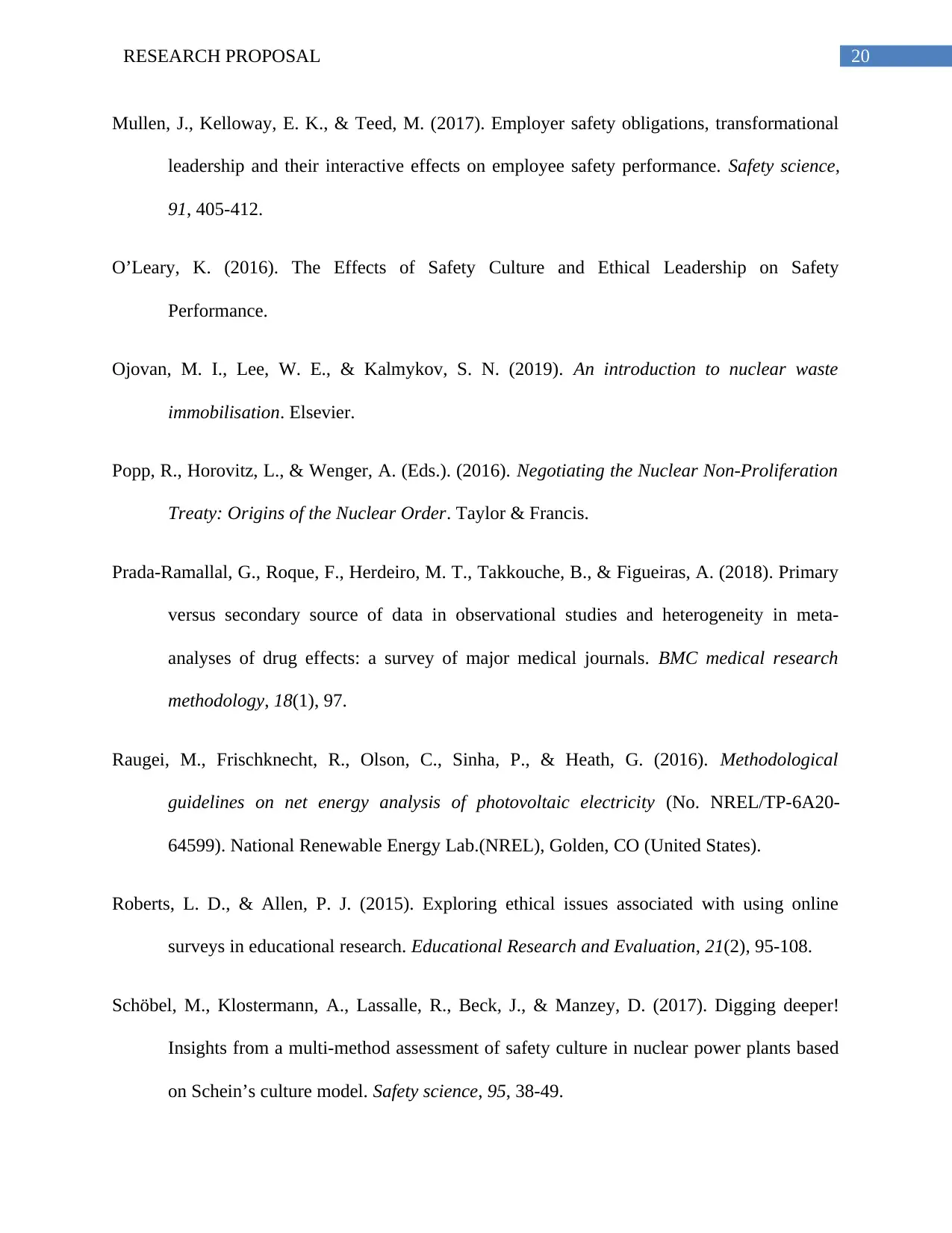
20RESEARCH PROPOSAL
Mullen, J., Kelloway, E. K., & Teed, M. (2017). Employer safety obligations, transformational
leadership and their interactive effects on employee safety performance. Safety science,
91, 405-412.
O’Leary, K. (2016). The Effects of Safety Culture and Ethical Leadership on Safety
Performance.
Ojovan, M. I., Lee, W. E., & Kalmykov, S. N. (2019). An introduction to nuclear waste
immobilisation. Elsevier.
Popp, R., Horovitz, L., & Wenger, A. (Eds.). (2016). Negotiating the Nuclear Non-Proliferation
Treaty: Origins of the Nuclear Order. Taylor & Francis.
Prada-Ramallal, G., Roque, F., Herdeiro, M. T., Takkouche, B., & Figueiras, A. (2018). Primary
versus secondary source of data in observational studies and heterogeneity in meta-
analyses of drug effects: a survey of major medical journals. BMC medical research
methodology, 18(1), 97.
Raugei, M., Frischknecht, R., Olson, C., Sinha, P., & Heath, G. (2016). Methodological
guidelines on net energy analysis of photovoltaic electricity (No. NREL/TP-6A20-
64599). National Renewable Energy Lab.(NREL), Golden, CO (United States).
Roberts, L. D., & Allen, P. J. (2015). Exploring ethical issues associated with using online
surveys in educational research. Educational Research and Evaluation, 21(2), 95-108.
Schöbel, M., Klostermann, A., Lassalle, R., Beck, J., & Manzey, D. (2017). Digging deeper!
Insights from a multi-method assessment of safety culture in nuclear power plants based
on Schein’s culture model. Safety science, 95, 38-49.
Mullen, J., Kelloway, E. K., & Teed, M. (2017). Employer safety obligations, transformational
leadership and their interactive effects on employee safety performance. Safety science,
91, 405-412.
O’Leary, K. (2016). The Effects of Safety Culture and Ethical Leadership on Safety
Performance.
Ojovan, M. I., Lee, W. E., & Kalmykov, S. N. (2019). An introduction to nuclear waste
immobilisation. Elsevier.
Popp, R., Horovitz, L., & Wenger, A. (Eds.). (2016). Negotiating the Nuclear Non-Proliferation
Treaty: Origins of the Nuclear Order. Taylor & Francis.
Prada-Ramallal, G., Roque, F., Herdeiro, M. T., Takkouche, B., & Figueiras, A. (2018). Primary
versus secondary source of data in observational studies and heterogeneity in meta-
analyses of drug effects: a survey of major medical journals. BMC medical research
methodology, 18(1), 97.
Raugei, M., Frischknecht, R., Olson, C., Sinha, P., & Heath, G. (2016). Methodological
guidelines on net energy analysis of photovoltaic electricity (No. NREL/TP-6A20-
64599). National Renewable Energy Lab.(NREL), Golden, CO (United States).
Roberts, L. D., & Allen, P. J. (2015). Exploring ethical issues associated with using online
surveys in educational research. Educational Research and Evaluation, 21(2), 95-108.
Schöbel, M., Klostermann, A., Lassalle, R., Beck, J., & Manzey, D. (2017). Digging deeper!
Insights from a multi-method assessment of safety culture in nuclear power plants based
on Schein’s culture model. Safety science, 95, 38-49.
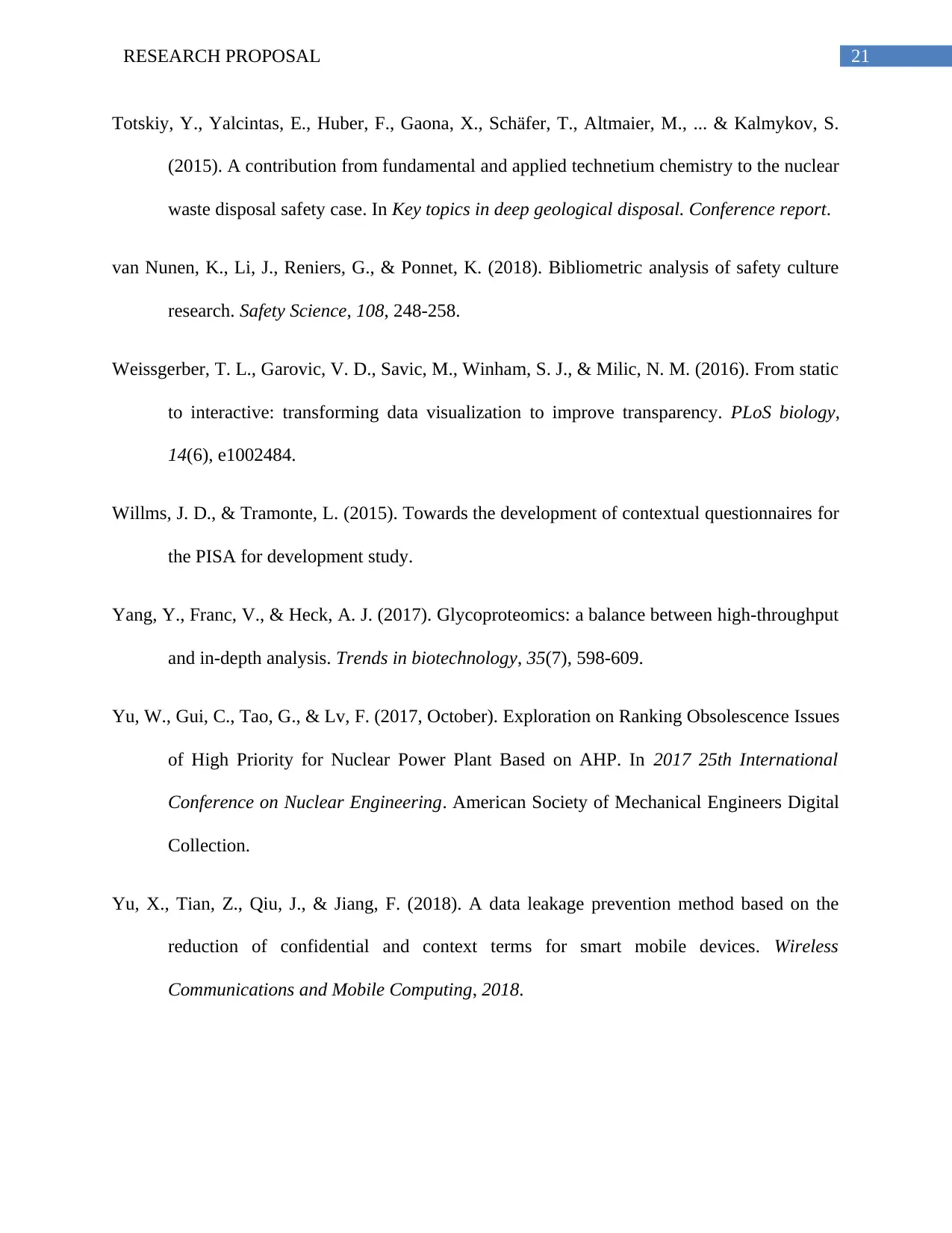
21RESEARCH PROPOSAL
Totskiy, Y., Yalcintas, E., Huber, F., Gaona, X., Schäfer, T., Altmaier, M., ... & Kalmykov, S.
(2015). A contribution from fundamental and applied technetium chemistry to the nuclear
waste disposal safety case. In Key topics in deep geological disposal. Conference report.
van Nunen, K., Li, J., Reniers, G., & Ponnet, K. (2018). Bibliometric analysis of safety culture
research. Safety Science, 108, 248-258.
Weissgerber, T. L., Garovic, V. D., Savic, M., Winham, S. J., & Milic, N. M. (2016). From static
to interactive: transforming data visualization to improve transparency. PLoS biology,
14(6), e1002484.
Willms, J. D., & Tramonte, L. (2015). Towards the development of contextual questionnaires for
the PISA for development study.
Yang, Y., Franc, V., & Heck, A. J. (2017). Glycoproteomics: a balance between high-throughput
and in-depth analysis. Trends in biotechnology, 35(7), 598-609.
Yu, W., Gui, C., Tao, G., & Lv, F. (2017, October). Exploration on Ranking Obsolescence Issues
of High Priority for Nuclear Power Plant Based on AHP. In 2017 25th International
Conference on Nuclear Engineering. American Society of Mechanical Engineers Digital
Collection.
Yu, X., Tian, Z., Qiu, J., & Jiang, F. (2018). A data leakage prevention method based on the
reduction of confidential and context terms for smart mobile devices. Wireless
Communications and Mobile Computing, 2018.
Totskiy, Y., Yalcintas, E., Huber, F., Gaona, X., Schäfer, T., Altmaier, M., ... & Kalmykov, S.
(2015). A contribution from fundamental and applied technetium chemistry to the nuclear
waste disposal safety case. In Key topics in deep geological disposal. Conference report.
van Nunen, K., Li, J., Reniers, G., & Ponnet, K. (2018). Bibliometric analysis of safety culture
research. Safety Science, 108, 248-258.
Weissgerber, T. L., Garovic, V. D., Savic, M., Winham, S. J., & Milic, N. M. (2016). From static
to interactive: transforming data visualization to improve transparency. PLoS biology,
14(6), e1002484.
Willms, J. D., & Tramonte, L. (2015). Towards the development of contextual questionnaires for
the PISA for development study.
Yang, Y., Franc, V., & Heck, A. J. (2017). Glycoproteomics: a balance between high-throughput
and in-depth analysis. Trends in biotechnology, 35(7), 598-609.
Yu, W., Gui, C., Tao, G., & Lv, F. (2017, October). Exploration on Ranking Obsolescence Issues
of High Priority for Nuclear Power Plant Based on AHP. In 2017 25th International
Conference on Nuclear Engineering. American Society of Mechanical Engineers Digital
Collection.
Yu, X., Tian, Z., Qiu, J., & Jiang, F. (2018). A data leakage prevention method based on the
reduction of confidential and context terms for smart mobile devices. Wireless
Communications and Mobile Computing, 2018.
1 out of 22
Related Documents
Your All-in-One AI-Powered Toolkit for Academic Success.
+13062052269
info@desklib.com
Available 24*7 on WhatsApp / Email
![[object Object]](/_next/static/media/star-bottom.7253800d.svg)
Unlock your academic potential
© 2024 | Zucol Services PVT LTD | All rights reserved.





